Flux #1
Created: Mon Oct 13 2025
A 4-day study on the Boiron River with an examination on observation techniques. Reseachers, PhD candidates, artists, designers, musicians, curators and architects come together to develop methodologies on how to observe nature. Organized by Benoît Renaudin and Marion Nielsen.
Day 1
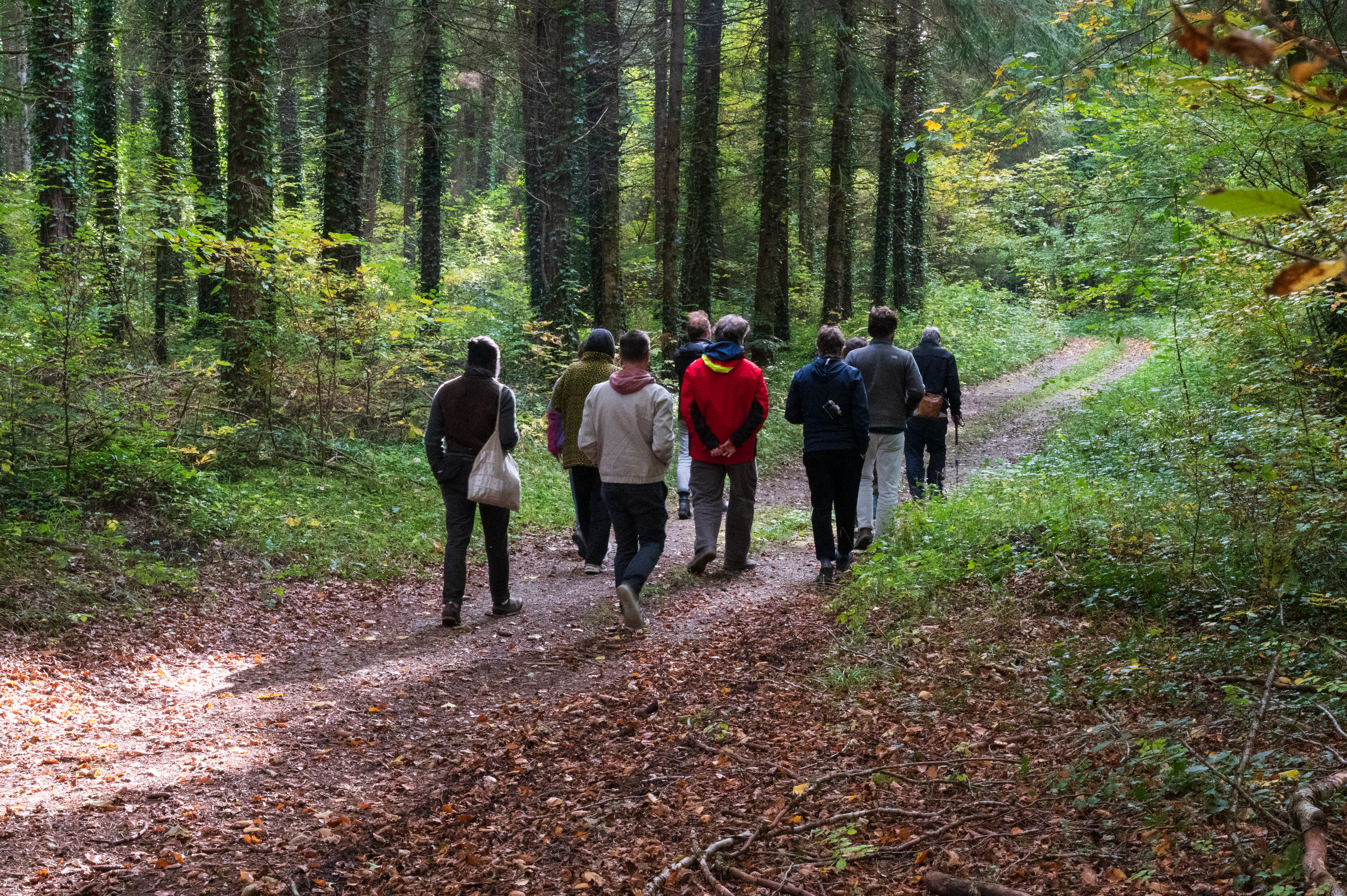 Damien and Jean-François from Maison de la Rivière took us around the area and along the Boiron River. They are essentially the land knowledge people and they are the ones that care for the territory.
Damien and Jean-François from Maison de la Rivière took us around the area and along the Boiron River. They are essentially the land knowledge people and they are the ones that care for the territory.
Boiron River
Source du Boiron
When we first arrived, Jean-François said it's an ugly place. But I think perhaps he was being sarcastic because I can't see why someone who cares for the place would see it as ugly, and then goes on to say that it's a magical place. Indeed, it is a magical place because I was immediately drawn by the source, also known as headwater in English.

 Water from the mountain flows underneath the ground forming a karst. It then arrives at this area where the water comes up from the ground which creates this bubbling effect.
Water from the mountain flows underneath the ground forming a karst. It then arrives at this area where the water comes up from the ground which creates this bubbling effect.
Long du Boiron
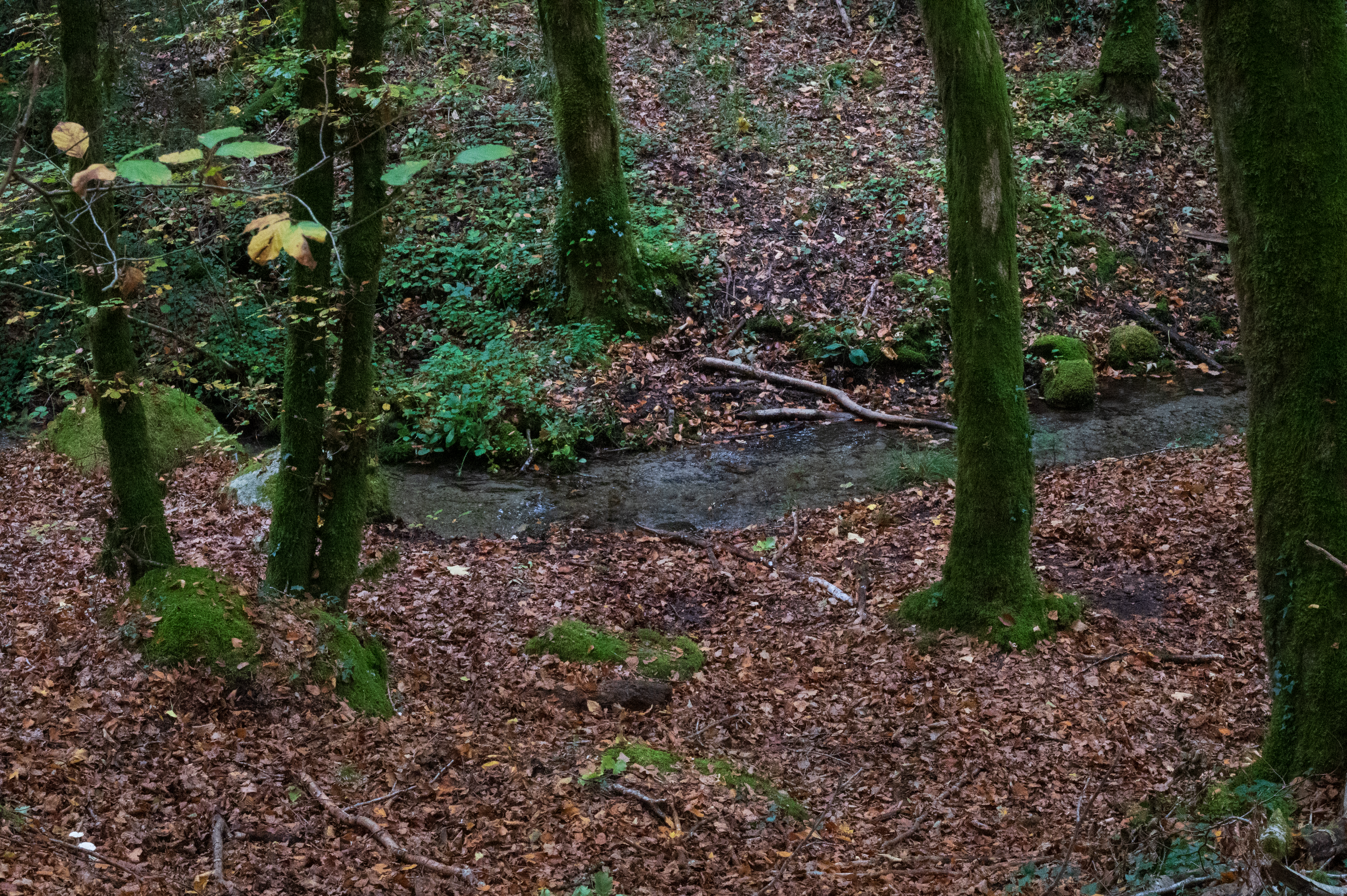

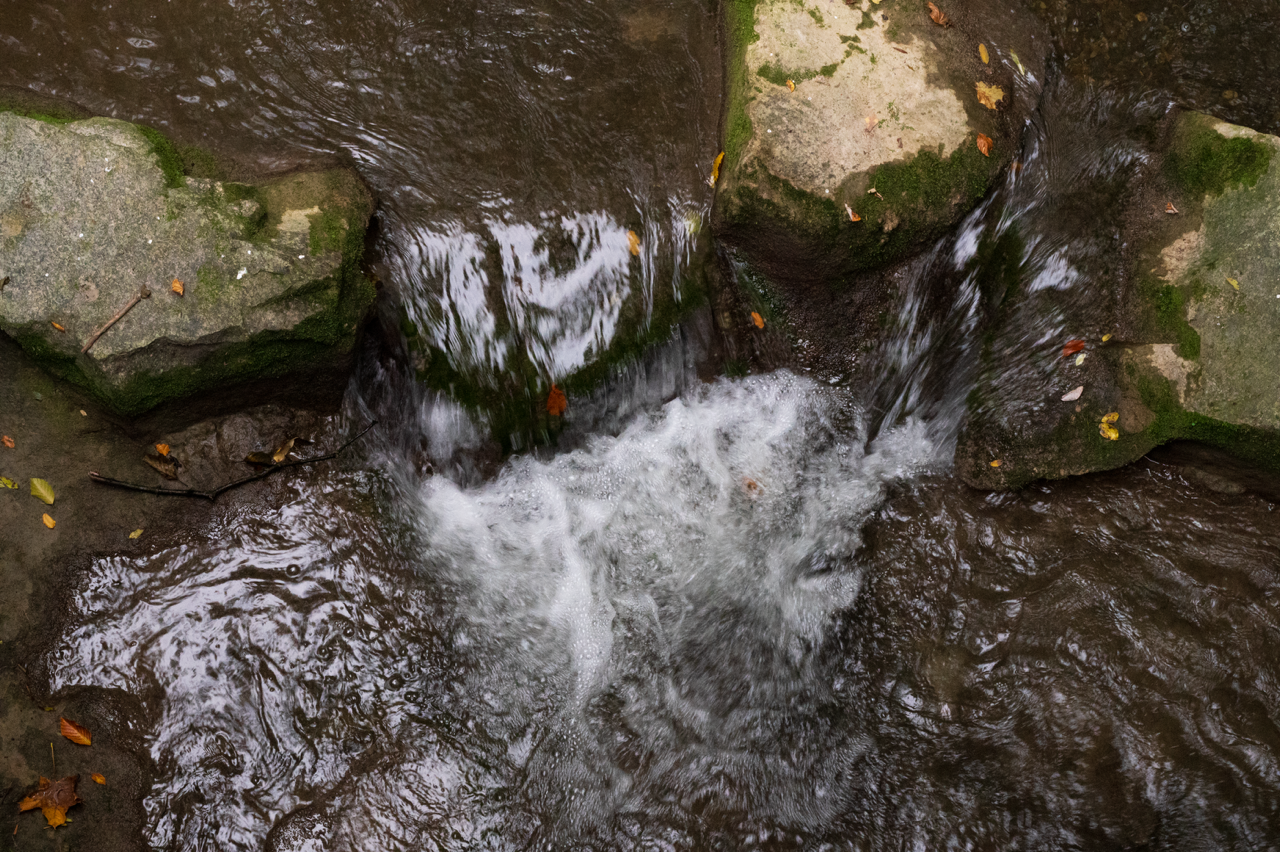

Cow Field
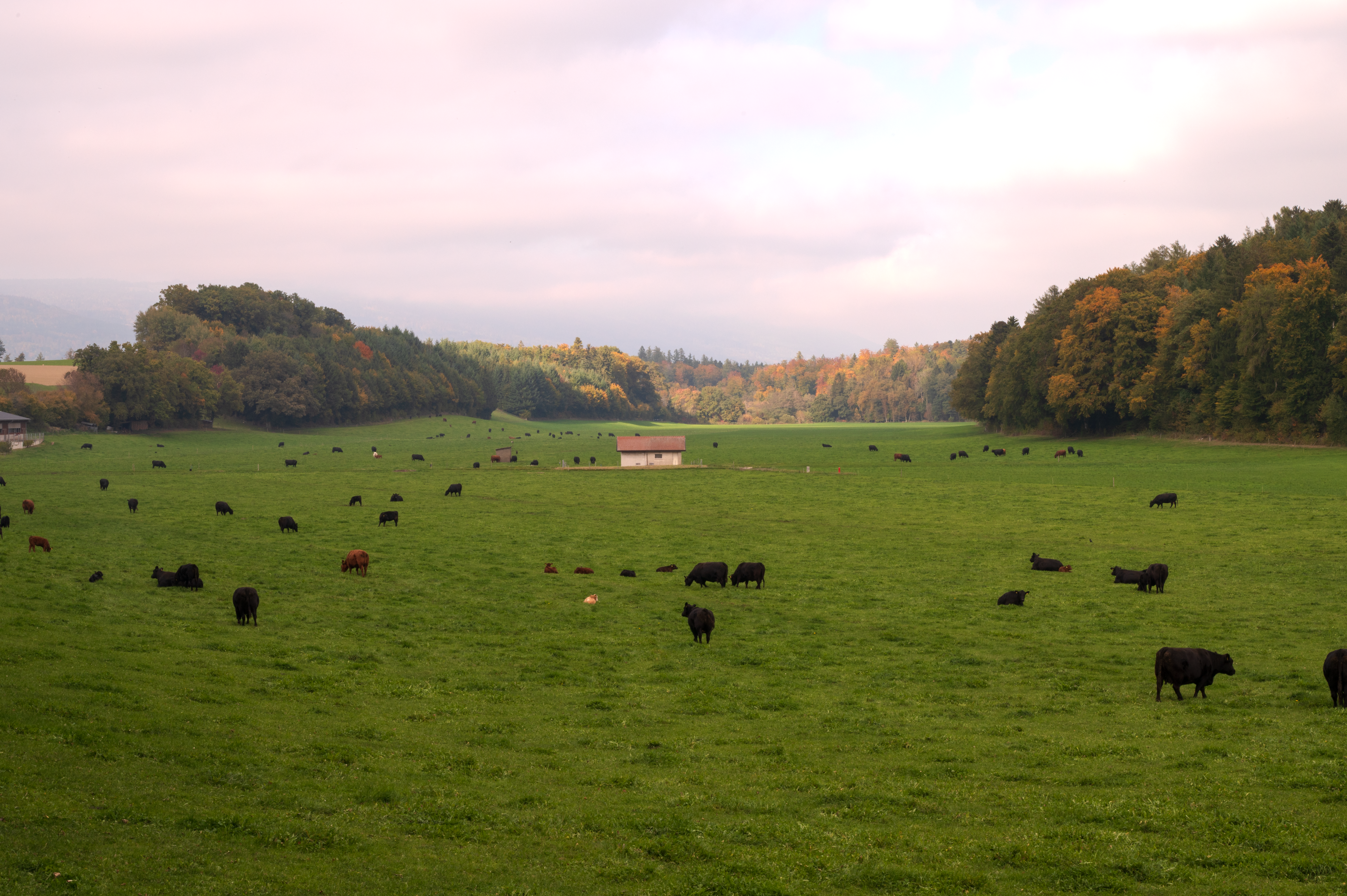 Not sure why we stopped here. Been using the Live Transcription accessibility feature on my Pixel so I can follow along the converation in French. But I didn't have it on for this part. Will ask my peers tomorrow about it.
Not sure why we stopped here. Been using the Live Transcription accessibility feature on my Pixel so I can follow along the converation in French. But I didn't have it on for this part. Will ask my peers tomorrow about it.
Asked Benoît, and he said there is a pipe that runs underneath here that directs and controls the river. This is near the intersection of Praz Riond, La Coudre and Froideville. We're used to thinking that rivers are above ground and natural, but in fact, we have shaped and forced them to behave otherwise.
Vineyard
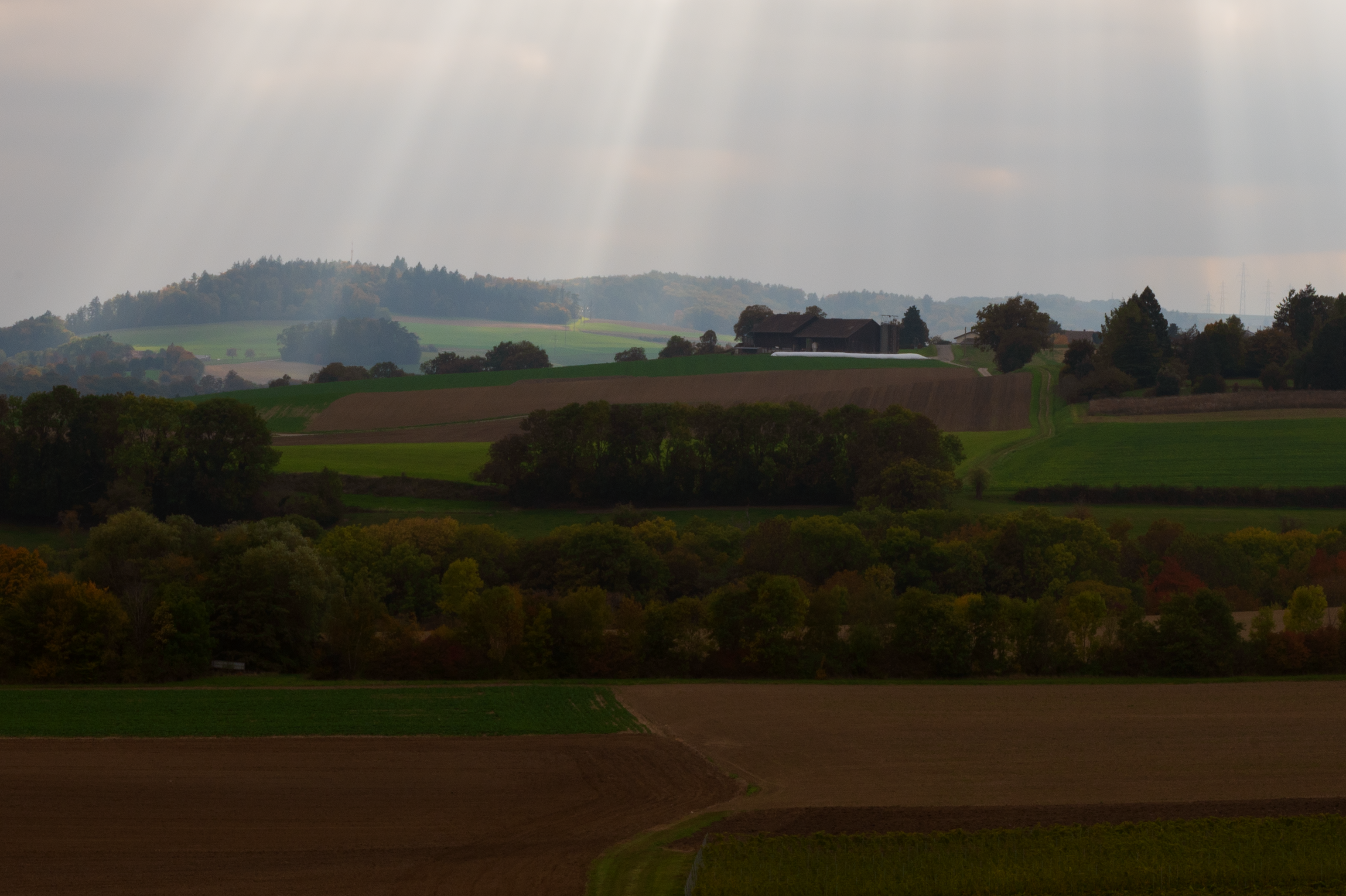
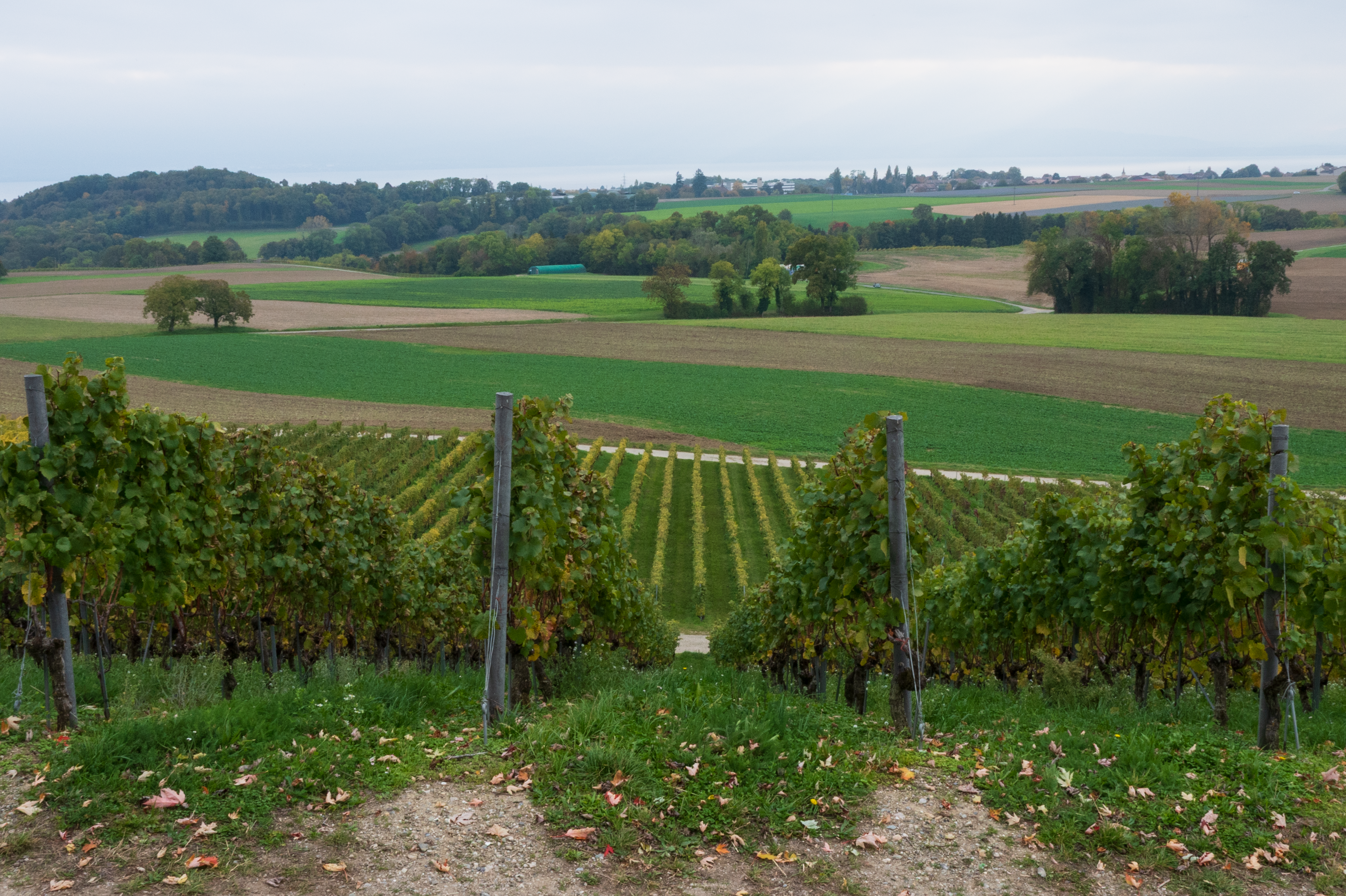 Pesticide chemicals are tested and they pass the safety measures that are designed for them to pass. But the pollutants add up over time and in reality, this isn't taken into consideration when testing chemicals in a lab.
Pesticide chemicals are tested and they pass the safety measures that are designed for them to pass. But the pollutants add up over time and in reality, this isn't taken into consideration when testing chemicals in a lab.
Gouettelette the Fairy
Jean-François, Head of Research at Maison de la Rivière, mentioned that there was a girl who was born near the Source du Boiron. « … il y a une petite fille qui vit ici donc c'est son endroit privilégié. Elle s'appelle Gouttelette. Elle est née là puis elle vit là près des sources. » Reading through the Maison de la Rivière 2022 Report, she was created in 2022 in response to how the people always told JF that the Maison was his baby. It truly shows his dedication to the the organization and the river. My takeaway is that there's a lore being created around the river through a magical tale. So far, there are two stories: Gouttelette la petite fée du Boiron and Gouttelette et la Perle de lune.
This reminds me of the 19th century approach to environmental aesthetics. Yuriko Saito notes in Appreciating Nature on Its Own Terms, "Influenced by the associationist aesthetic theory then popular in Europe, it located the aesthetic value of an object in the series of associated ideas it evokes. Adoption of this associationist theory caused nineteenth century Americans a great deal of anxiety because American landscape, in general, unlike that of Europe, was considered lacking in historical and literary associations." JF wasn't panicking to have literary association with the river, but it does beg the question, why are there literary associations for some natural objects and landscapes while not for others? Perhaps it's because of nature's beauty to attract (and detract) us from certain landscapes. For JF, the story was created out of love for the place and his personal connection to the place. Through the stories about Gouettelette along the river, locals and people afar will also be able to associate the river through magic as the world of Gouettelette grows bigger and bigger.
What I find interesting is that this story is created by a researcher and ecologist. This contradicts Allen Carlson's Natural Environmental Model. The kicker is that the story is coming from a scientist. To expand on this, there's "Aesthetic Appreciation and the Many Stories About Nature" by Thomas Heyd.
Transcript
Since I'm having a hard time following in French, I've been using the live transcription accessibility feature on my Pixel phone. It's not perfect but it's good enough.
Read Day 1 Transcript
Day 2
Exercise 1
 Find an object in the forest and ask 20 questions about it. I noticed this the first day and I wasn't sure what it was. And I took this opportunity to question about it.
Find an object in the forest and ask 20 questions about it. I noticed this the first day and I wasn't sure what it was. And I took this opportunity to question about it.
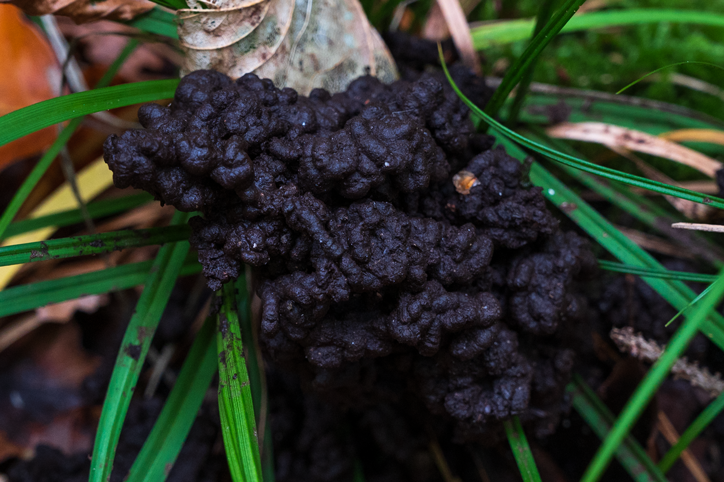
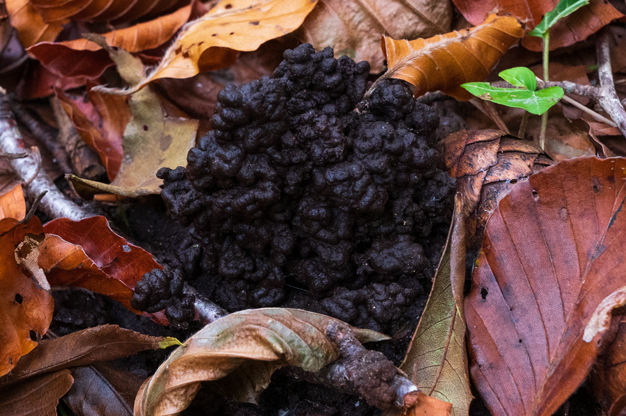
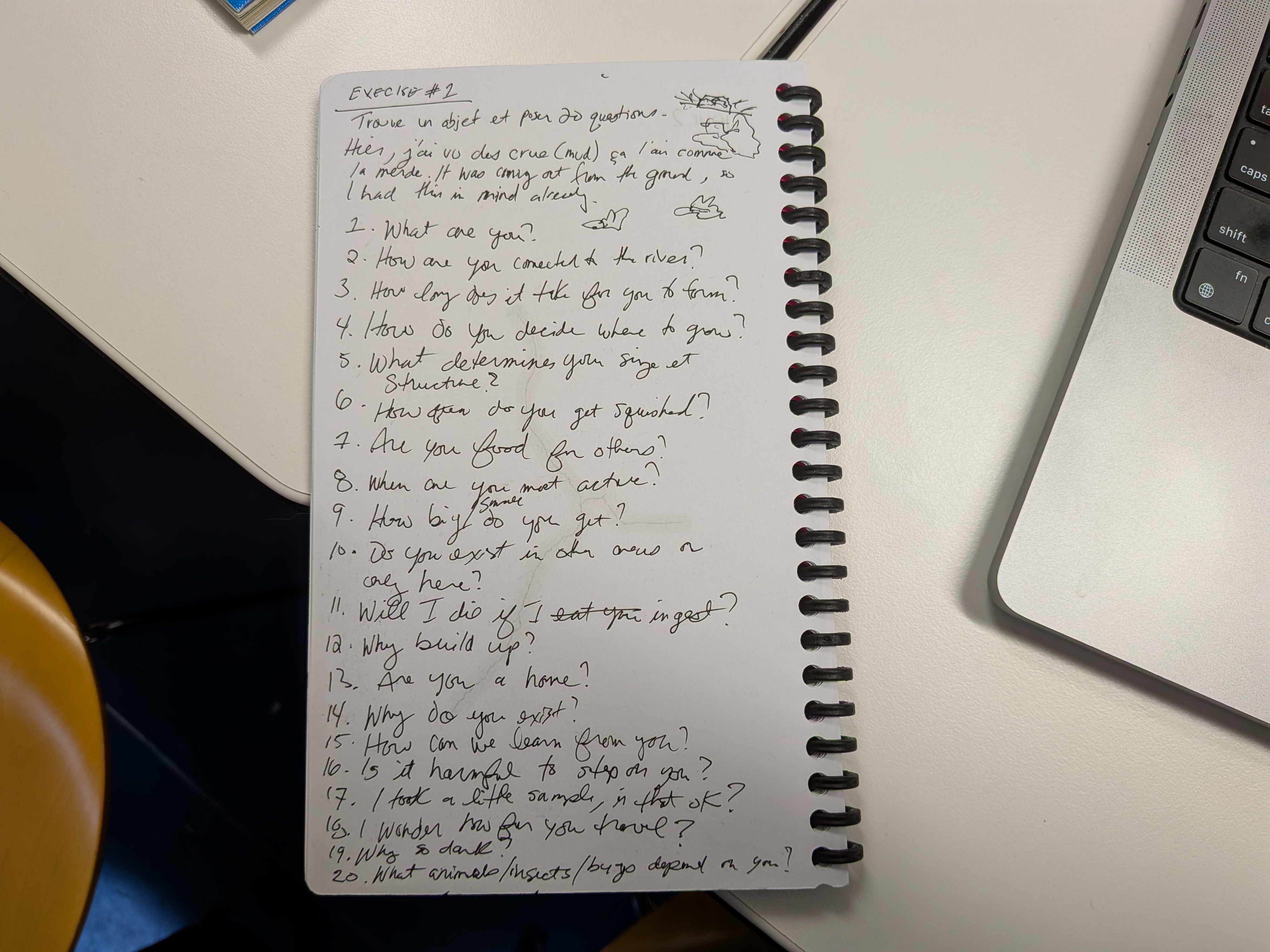 It looked like excrement but I thought maybe it was mud because there was so much on the ground. But ya, turned out to be excrement from worms called casting. Thank you Olivier for letting me know.
It looked like excrement but I thought maybe it was mud because there was so much on the ground. But ya, turned out to be excrement from worms called casting. Thank you Olivier for letting me know.
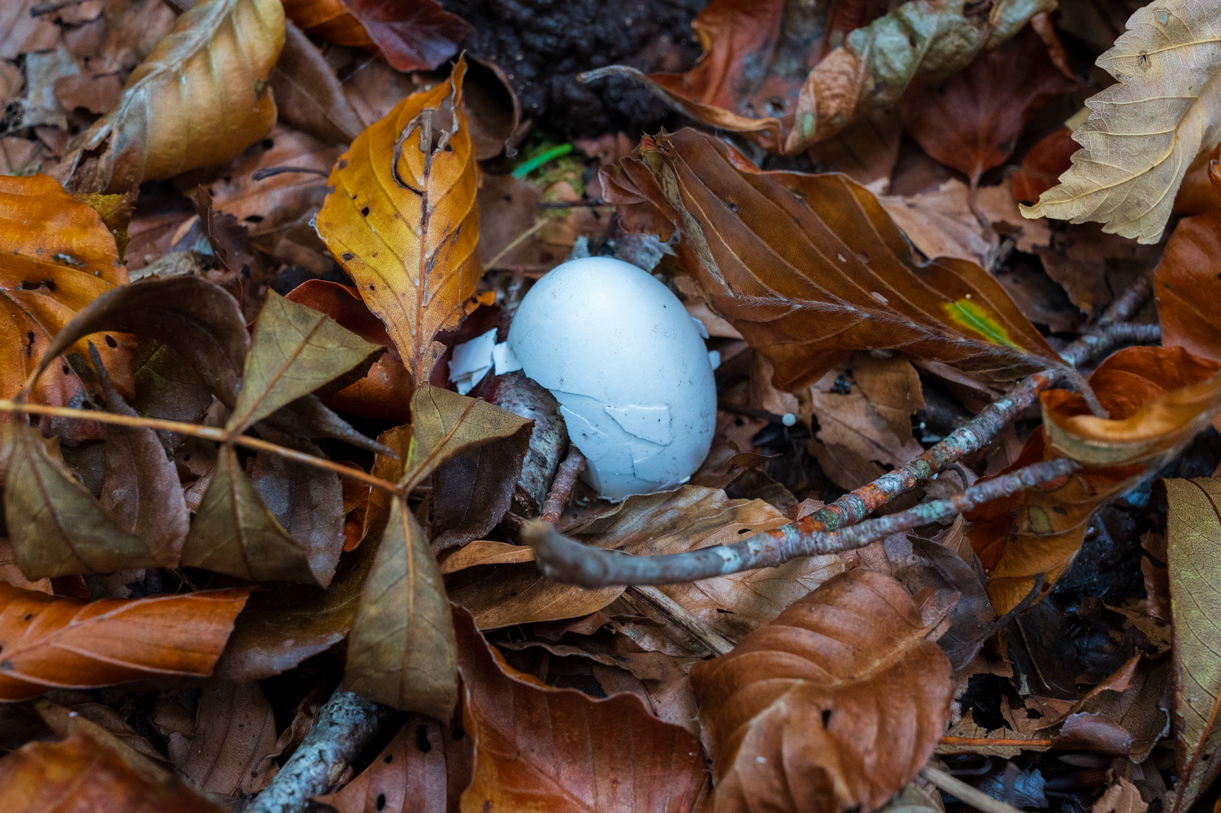 Oh and I found an egg shell and also went through the same exercise by asking 20 questions about this egg.
Oh and I found an egg shell and also went through the same exercise by asking 20 questions about this egg.
Boiron Creature
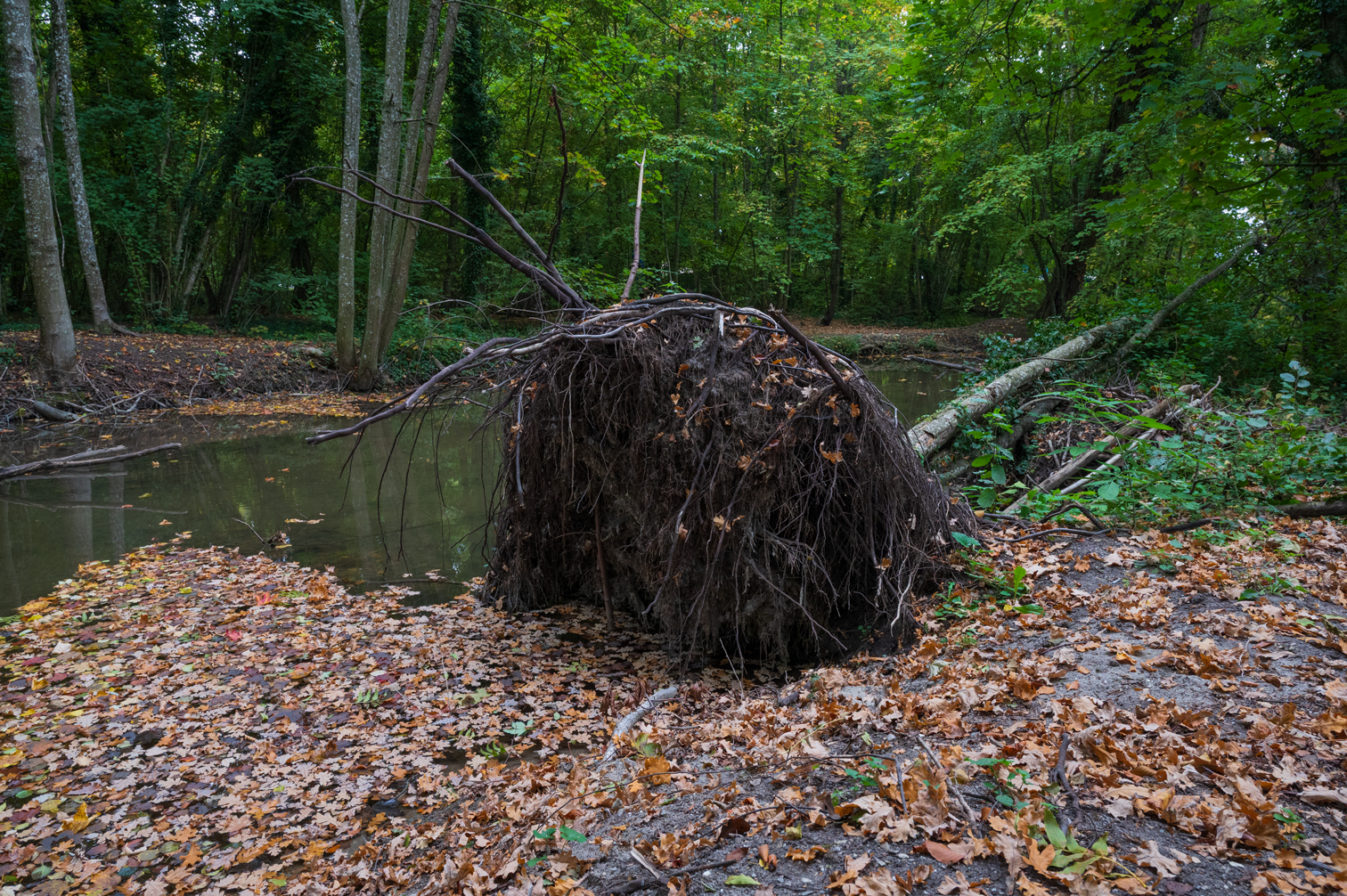
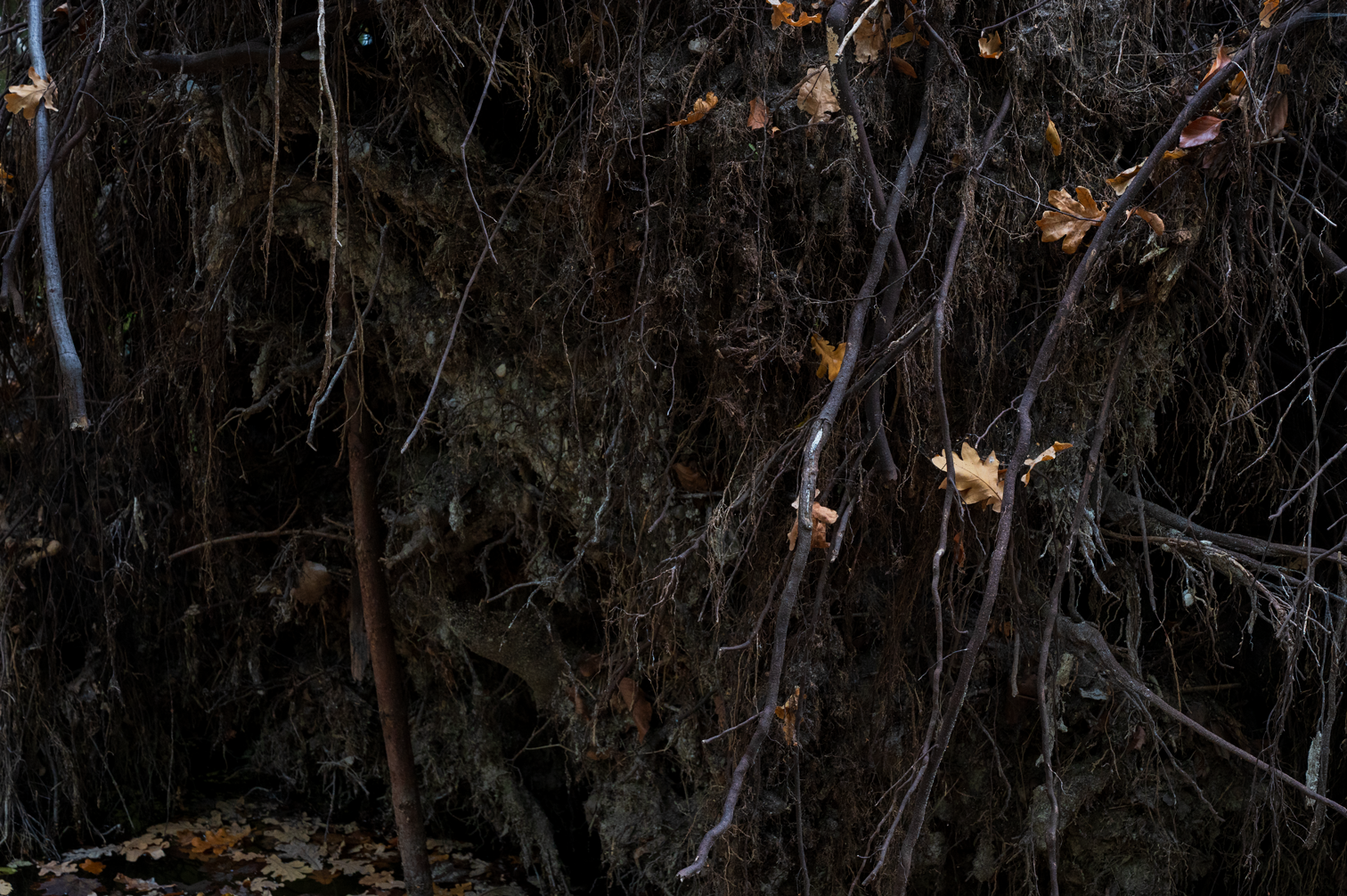 Noticed this structure hunched over the bank of the river. I gave it a story in my head that it's the protector of the river before the water enters Lac Léman.
Noticed this structure hunched over the bank of the river. I gave it a story in my head that it's the protector of the river before the water enters Lac Léman.
Boiron Exit
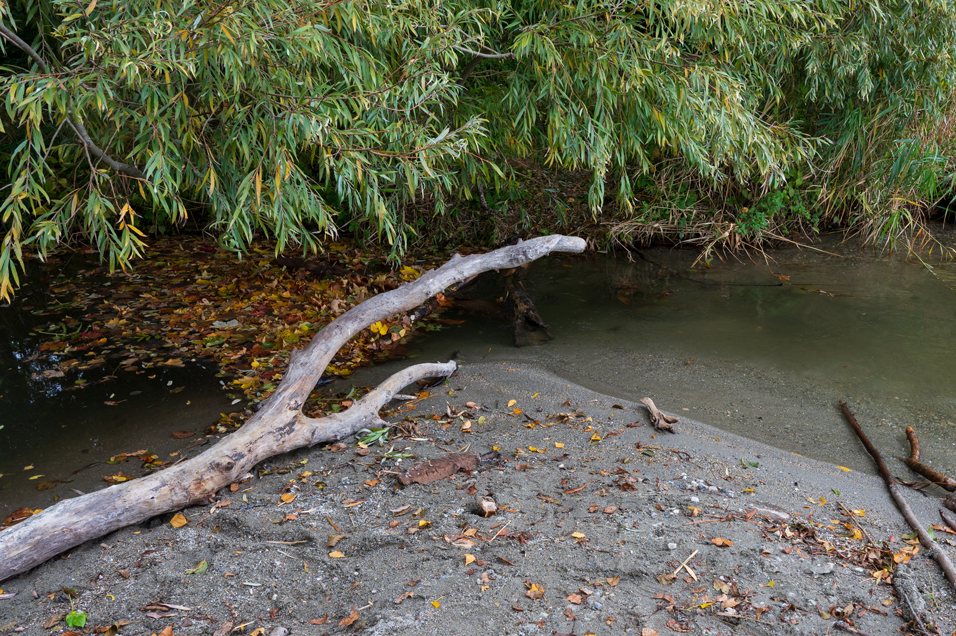 We took a walk to where the Boiron River enters Lac Léman. I can't remember where I made the revelation, but it made me think about how the lake is made up of many waters which then arrives at the Rhône river. From what I've read, the Rhône river is talked about in connection to the lake and the Rhône glacier from Valais. But it's important to think about the smaller water sources that make it to the lake.
We took a walk to where the Boiron River enters Lac Léman. I can't remember where I made the revelation, but it made me think about how the lake is made up of many waters which then arrives at the Rhône river. From what I've read, the Rhône river is talked about in connection to the lake and the Rhône glacier from Valais. But it's important to think about the smaller water sources that make it to the lake.
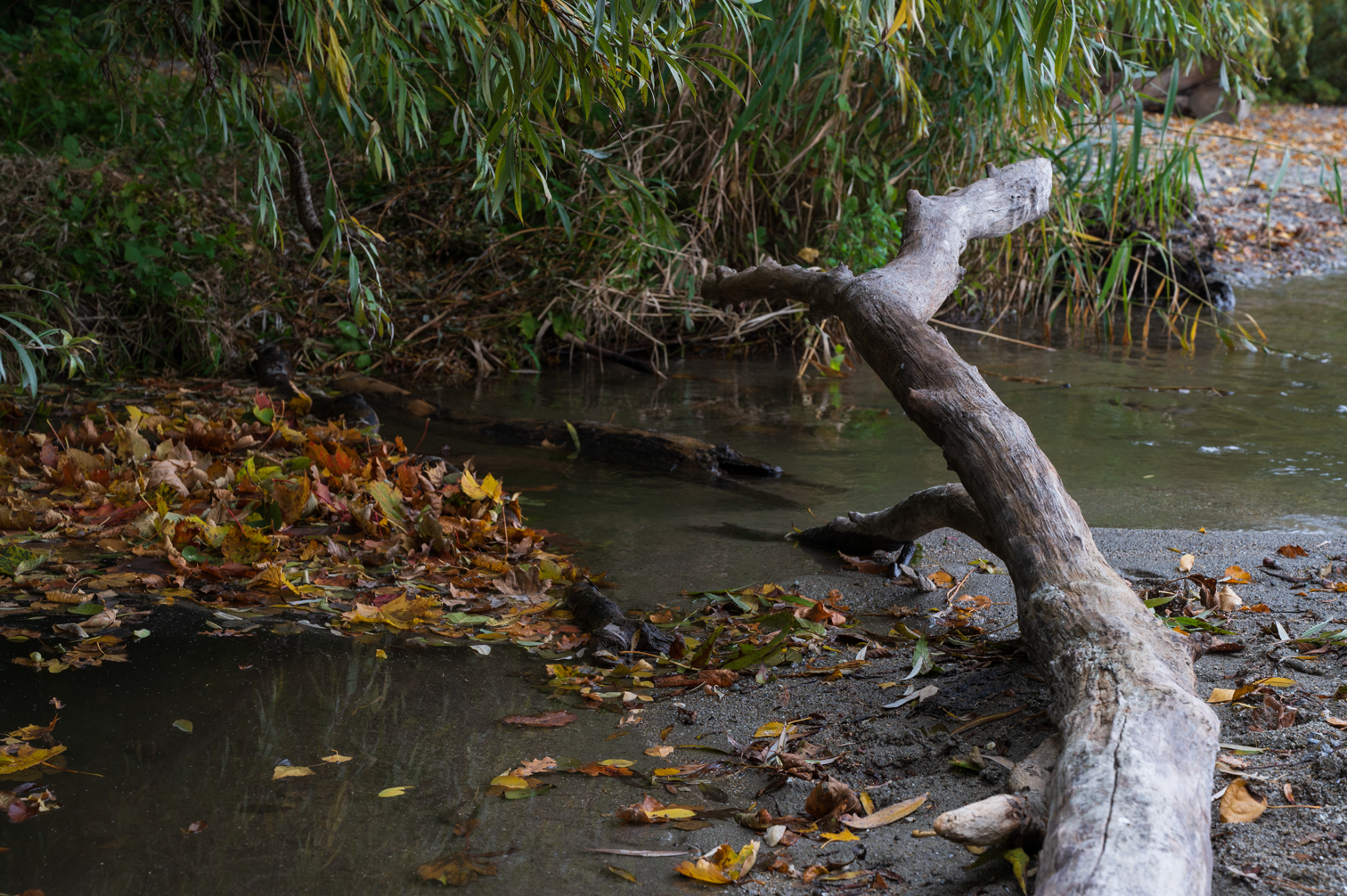 The reason being is that the Boiron river gets polluted through agriculture and wine production from pesticides. I wonder what the pollution level is like in the lake and how it trickles down into the Rhône.
The reason being is that the Boiron river gets polluted through agriculture and wine production from pesticides. I wonder what the pollution level is like in the lake and how it trickles down into the Rhône.
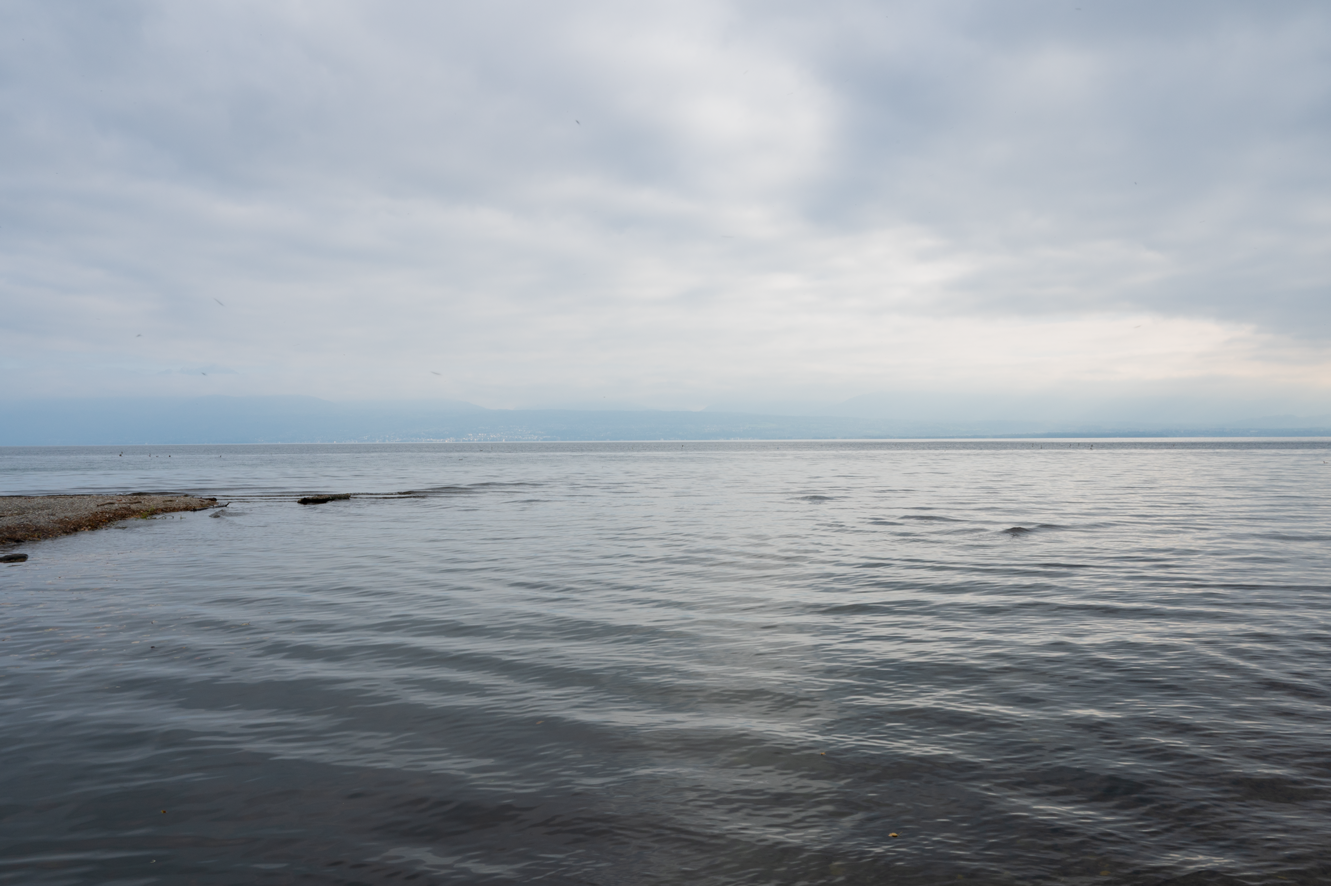
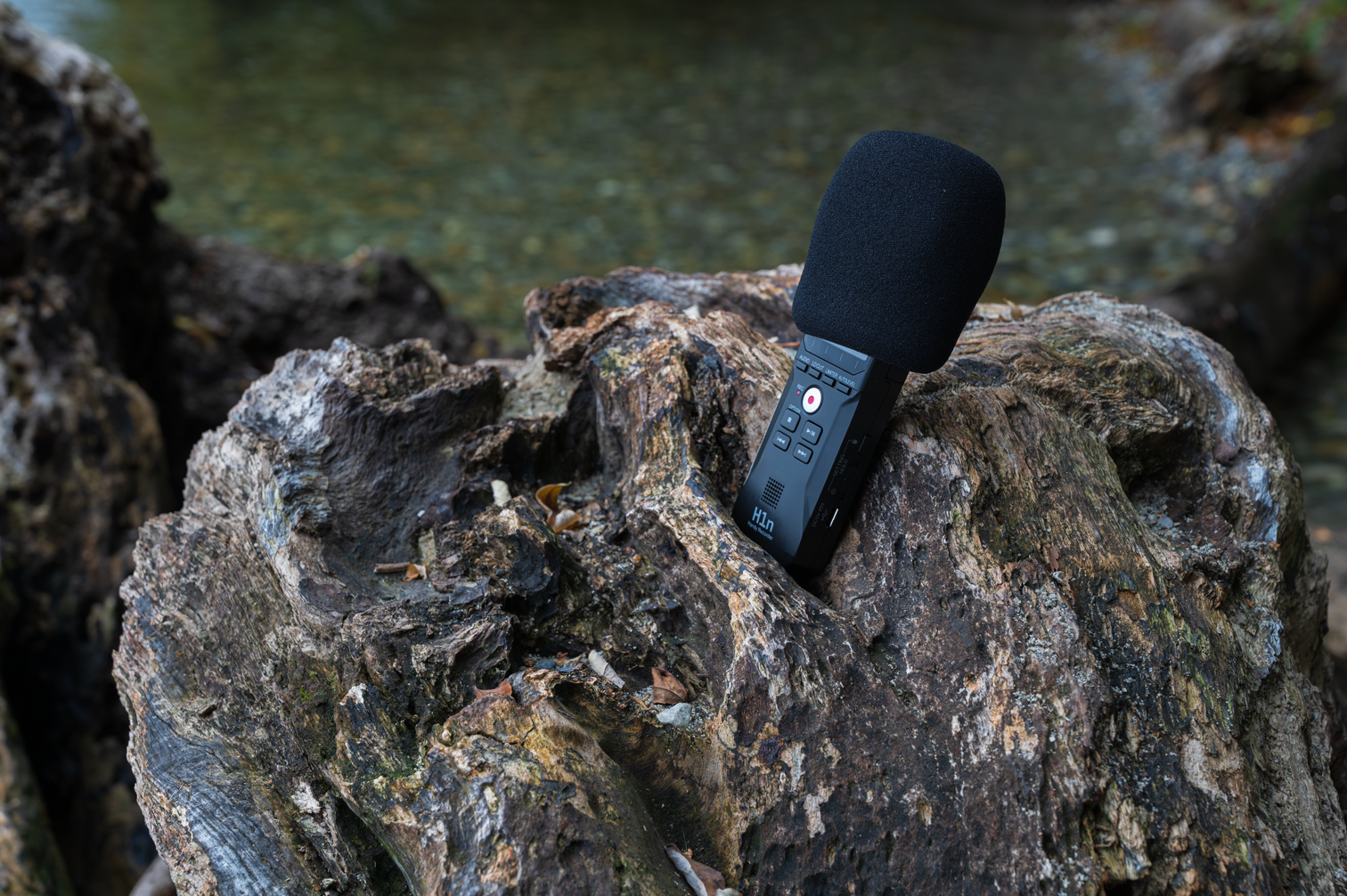 Also have some field recordings of soundscapes. Will need to edit and upload to Aporee.
Also have some field recordings of soundscapes. Will need to edit and upload to Aporee.
Garbage
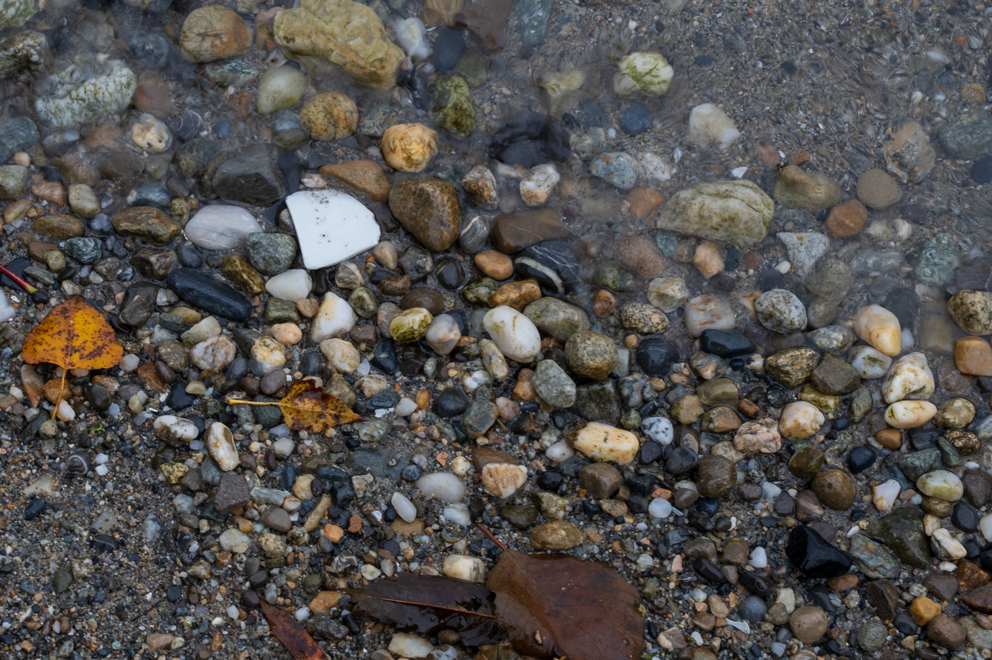 This white plastic piece kind of blends into the rest of the rocks.
This white plastic piece kind of blends into the rest of the rocks.
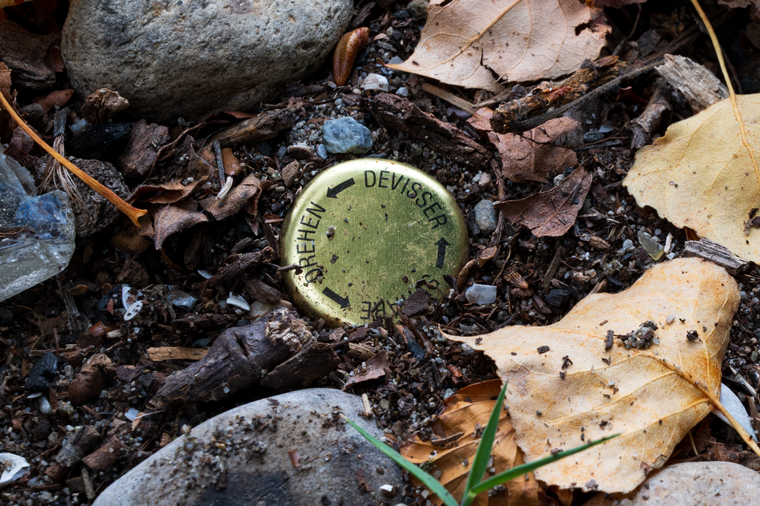 The arrows on the cap reminds me of the recycling symbol but it's in fact saying to unscrew in the direction of the arrows. Maybe a better translation in English would be, "twist". Anyway, this week has been filled with lots of French and I've learned new words.
The arrows on the cap reminds me of the recycling symbol but it's in fact saying to unscrew in the direction of the arrows. Maybe a better translation in English would be, "twist". Anyway, this week has been filled with lots of French and I've learned new words.
Sign
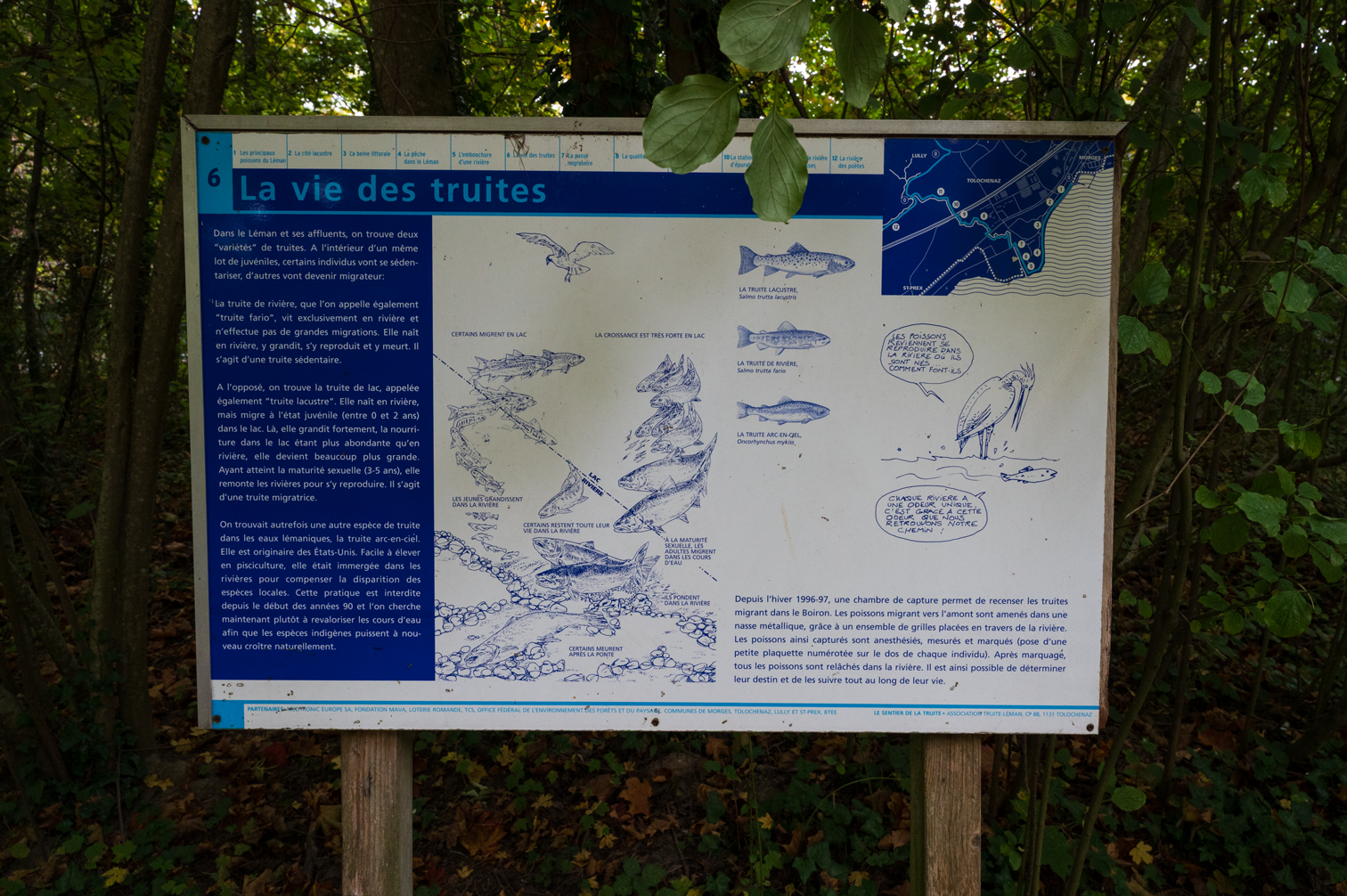 Putting this here to read later.
Putting this here to read later.
Fish
We saw the aquarium on the first day and I wanted a better look at the fish but forgot to take photos of the signs...So if I have the names of the fish wrong, someone let me know.
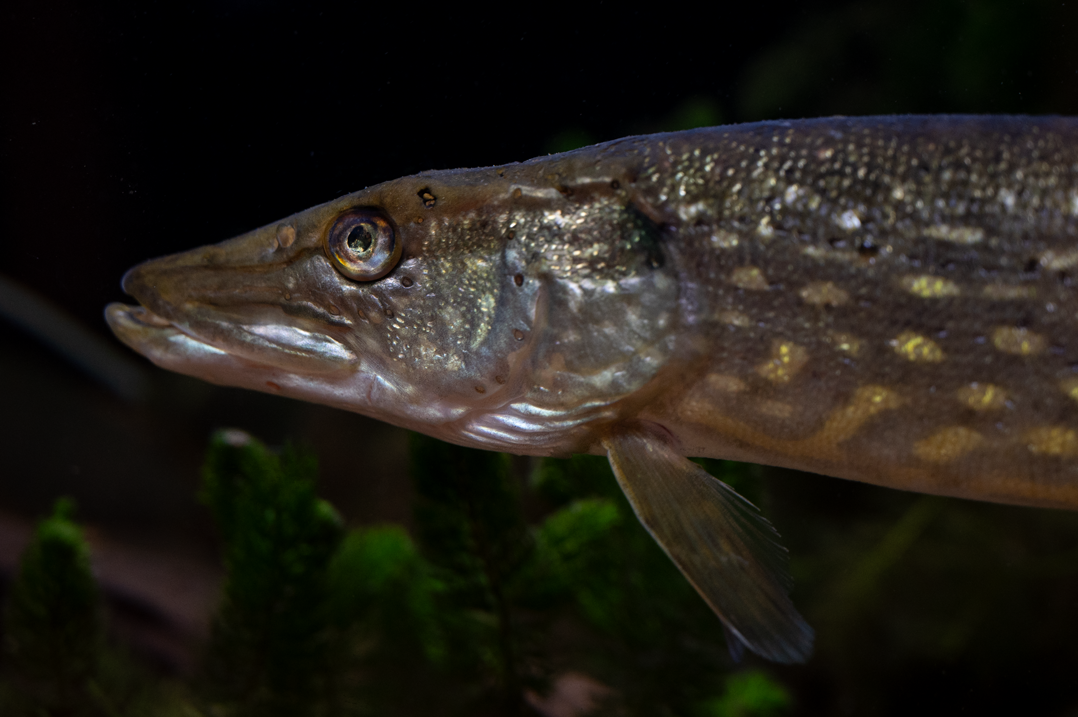 Brochet / Pike
Brochet / Pike
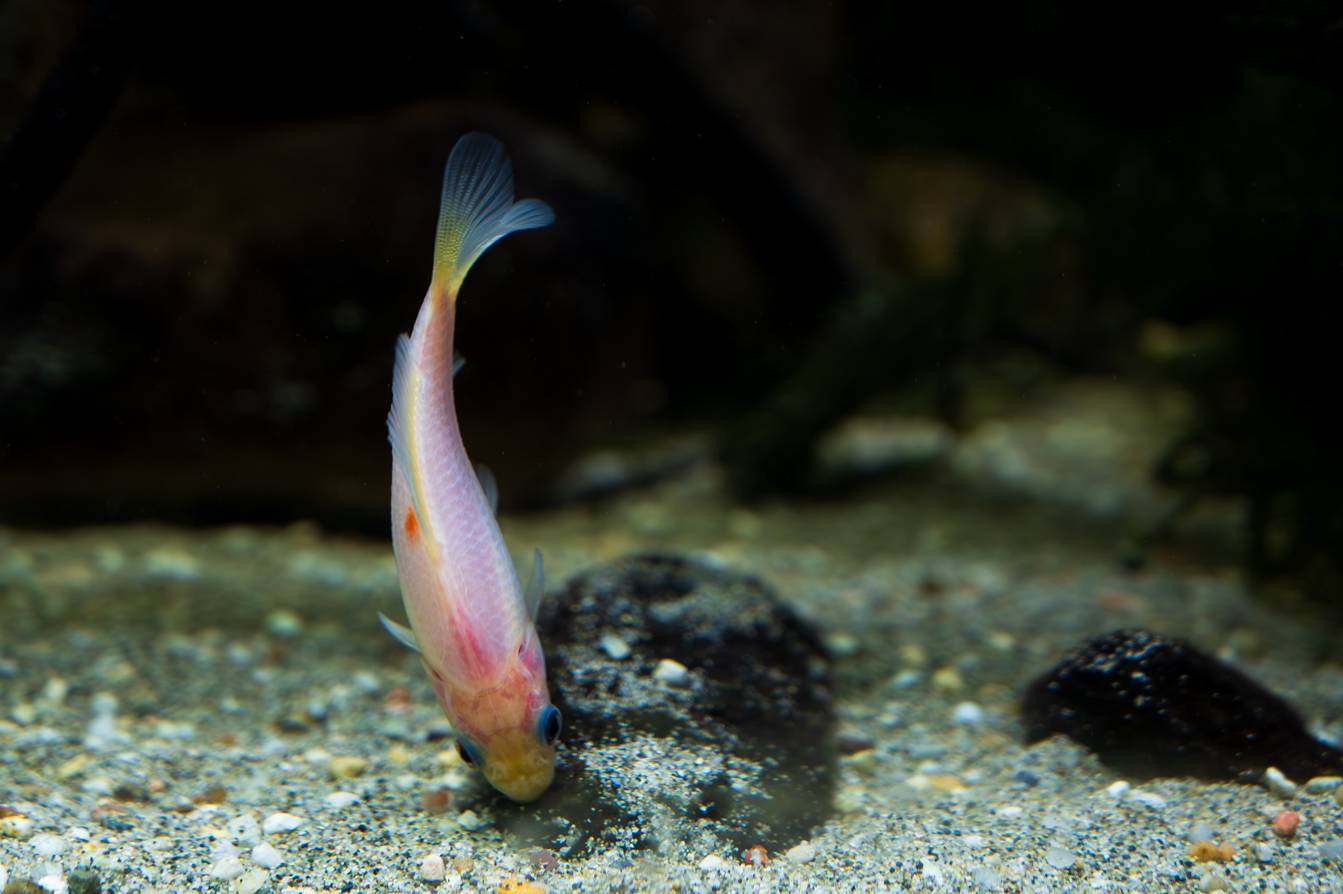 Poisson Rouge / Goldfish
Poisson Rouge / Goldfish
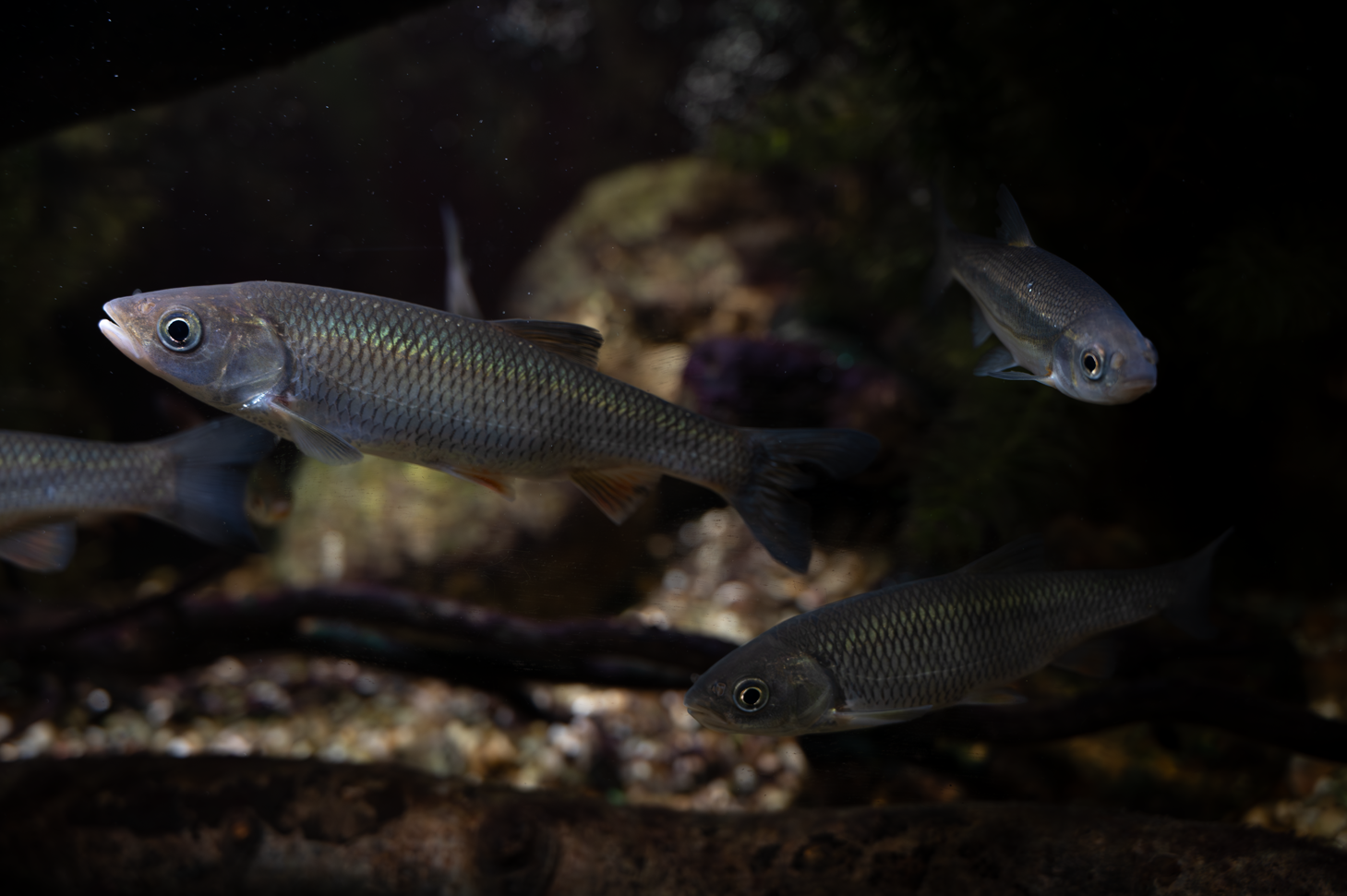
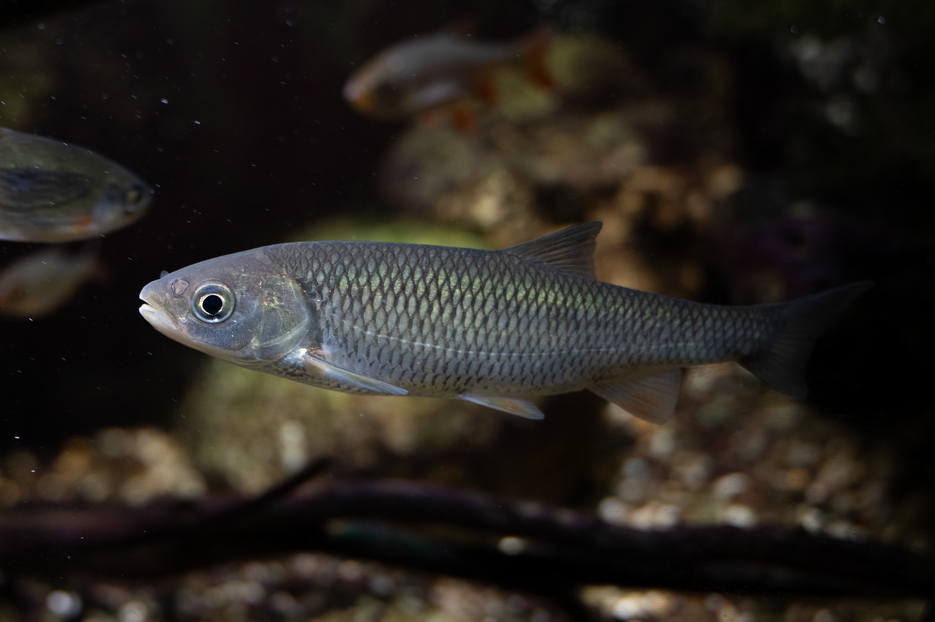 Chevaine / Chub
Chevaine / Chub
 Truite Fario / Brown Trout
Truite Fario / Brown Trout
A PDF with information on the fish of the area.
Learn More
Print Material
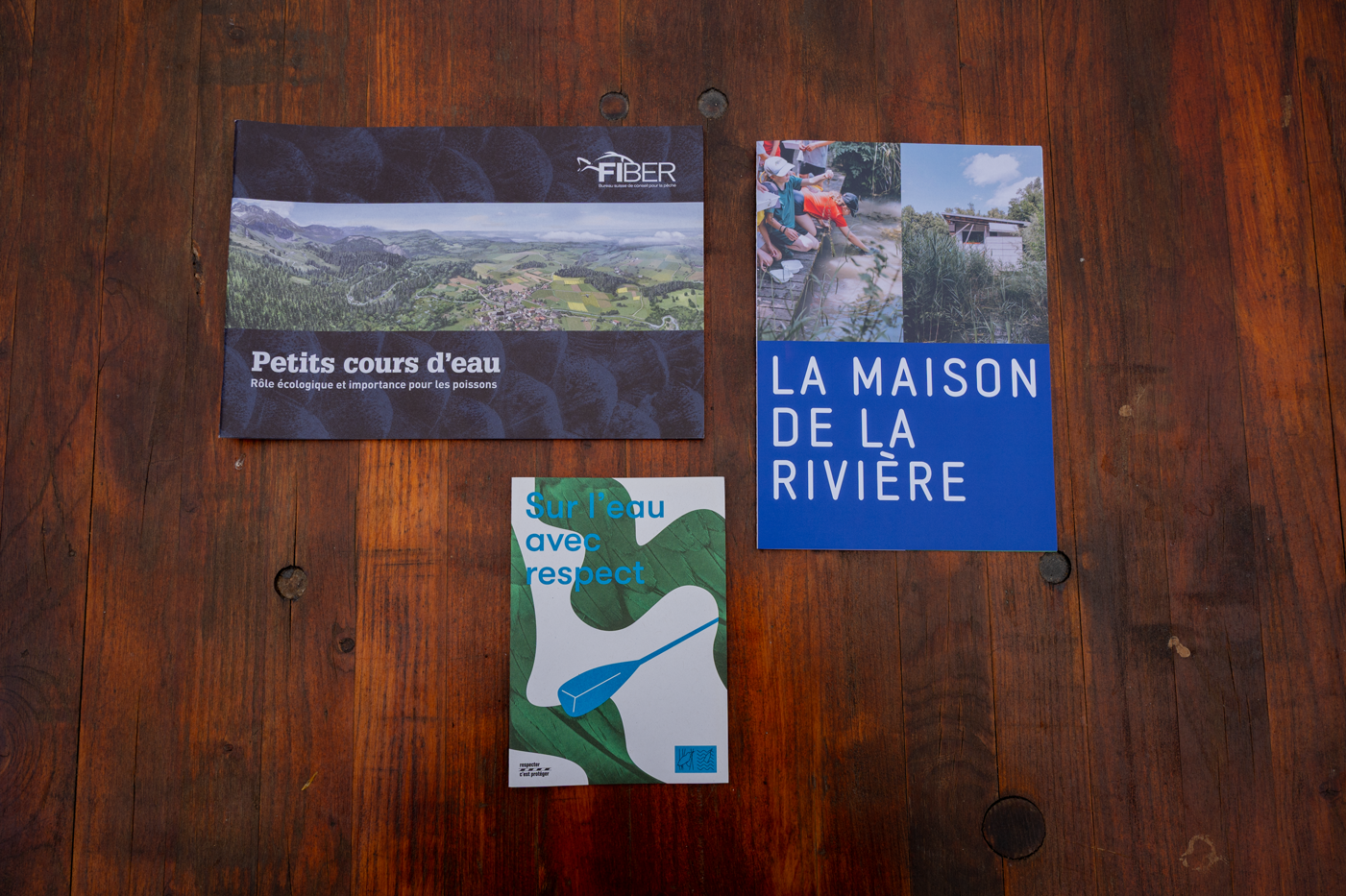
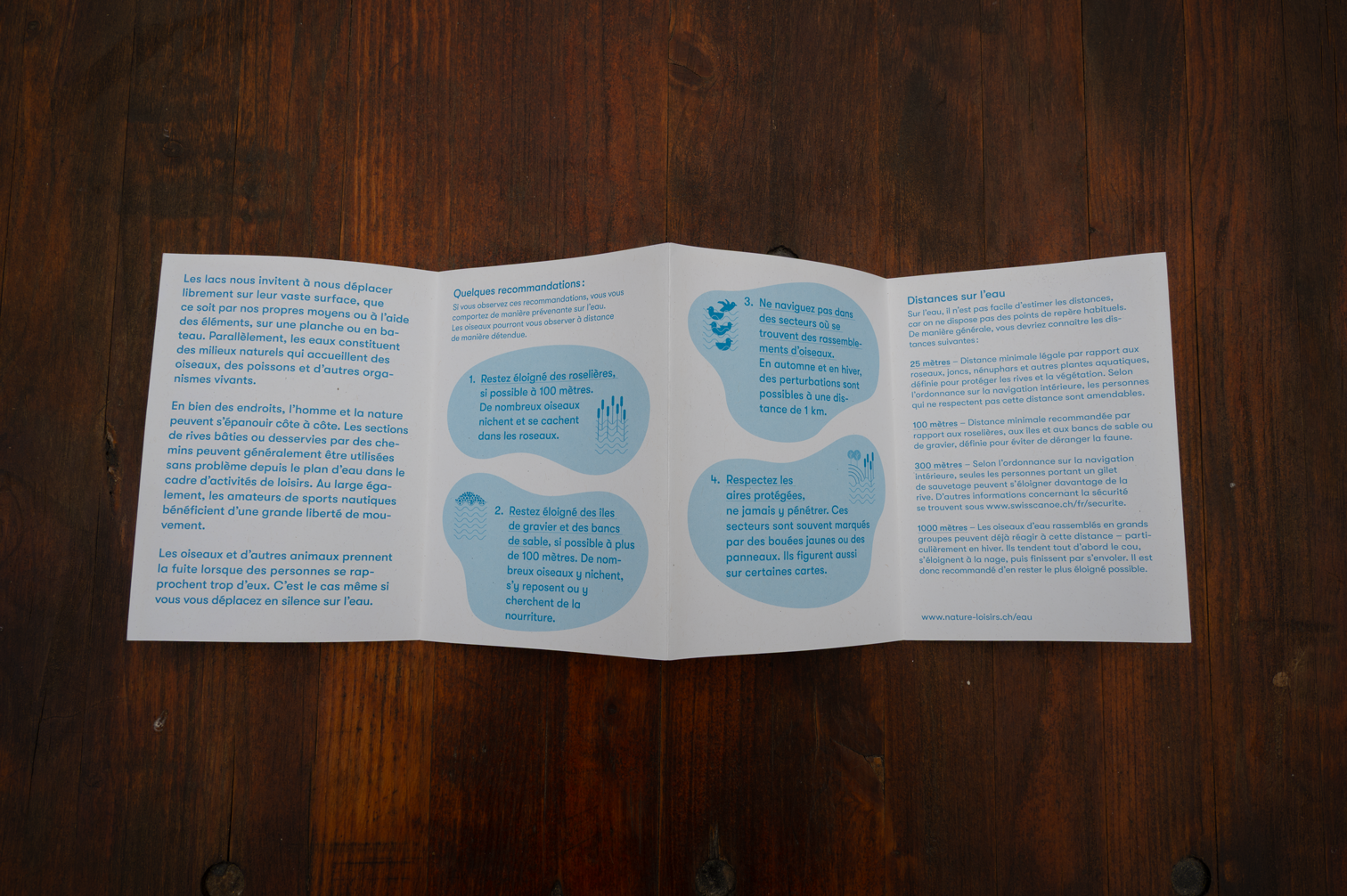 Takeways from these are ways to approach nature respectfully. Think this is important when we are researchers because we want to learn from nature without disturbing it.
Takeways from these are ways to approach nature respectfully. Think this is important when we are researchers because we want to learn from nature without disturbing it.
Check out the link to read the text from "Sur l'eau avec respect" and to see other print materials from them. Visit Nature Loisirs
In "Petits cours d'eau", the first paragraph says "Les petits ruisseaux sont l'épine dorsale de notre infrastructure écologique". The use of the word "backbone" is anthropomorphising the small streams which contributes to the concept I've been thinking about for the production of my observations. This also plays in to the idea of nature's beauty detracting us from "less important" natural entities. For example, the Rhône is easily identifiable as beautiful for it's clear water and also the fact that it's a larger river. So valuable/beautiful that there was a project called Appel du Rhône to adovocate for its legal personhood. But if small rivers are important to the ecological system, shouldn't we also care for it? And I wonder, is it because it's harder to see the beauty in the small rivers or is it because they are small that it's easy for us to ignore.
Here's a link to the document to lear more about the small water course. View PDF
Task of the Day
To come up with a protocol that will be our way of doing observation on the river. Some ideas I came up with are:
1. Hyperfixation Approach a landmark like the Source du Boiron from multiple perspectives and vantage points. In addition, spend as much time as possible with it. This is inspired by many things. As I told the group, my first year during my undergrad, in our art history course we were given an exercise to walk outside very slowly. Then, my first year in my masters we did a similar exercise on Le Viaduc de la Jonction where we walked back and forth twice with no technology and taking mental notes. Lastly, when I was uploading field recordings to Aporee from the viaduct, I started first writing the description as "the entrance of the bridge" but in fact, there is no entrace/exit since it depends on your trajectory. I am biased that I see the south side of the bridge as the entrance because this is where I enter every morning so I see it as the start of my day.
So, I wanted to use this opportunity to be in nature and not be defined by the paths that are already created for you to walk on. I wanted to come from all directions but arrive at a single point, the landmark.
2. Collection Inspired by land artist Andy Goldsworthy and Ursus Wehrli, a Swiss comedian and artist. The idea is to perform and make with nature in the sense that you are working with the material that is already embedded in the environment. Collect a single type of object and arrange them based on their visual qualities. For example, leaves and their shape or colour. Branches and their length, or rocks and their shape.
3. Story Since I kind of had an inclination that I would like to create a story about Boiron or personify it in someway, I thought maybe this could be a good opportunity to start writing on it. The protocol here is to find 3-5 objects and create a story about them and how they are interlinked. Based the story on how the objects speak to you, examine why you chose these objects and find their commonalities and differences.
Transcript
Talks about exercise done at the source and presentation of people's projects and work.
Read Day 2 Transcript
Day 3
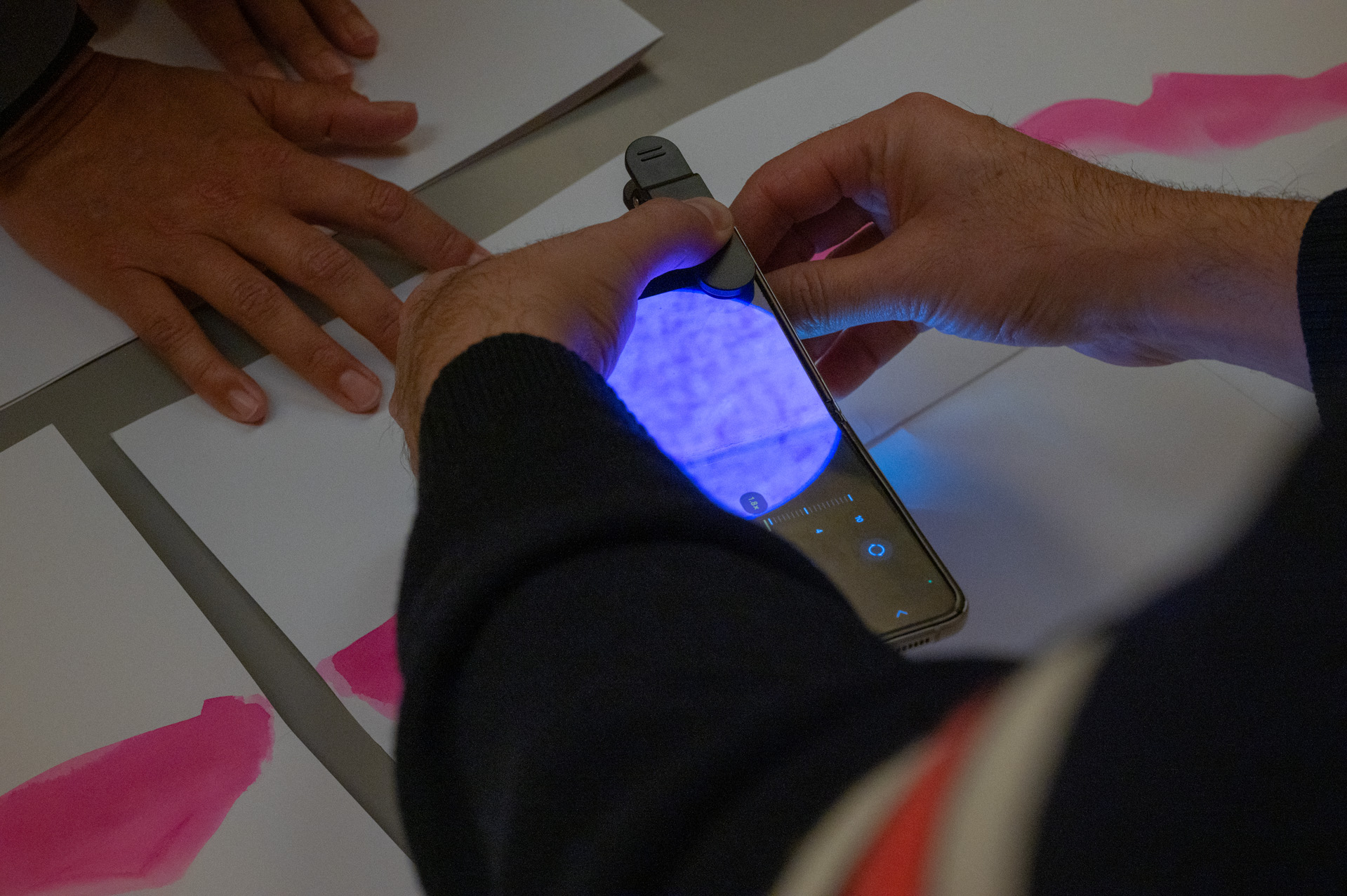
We kicked off the day with everyone talking about what they plan on doing for the day. The objective was to execute our protocol. I spent most of the day at the source. It's been calling since day 1. Even on day 2, I went there to do observations, but today I was by myself and didn't have to worry about time. I had about 2.5 hours to complete my protocol.
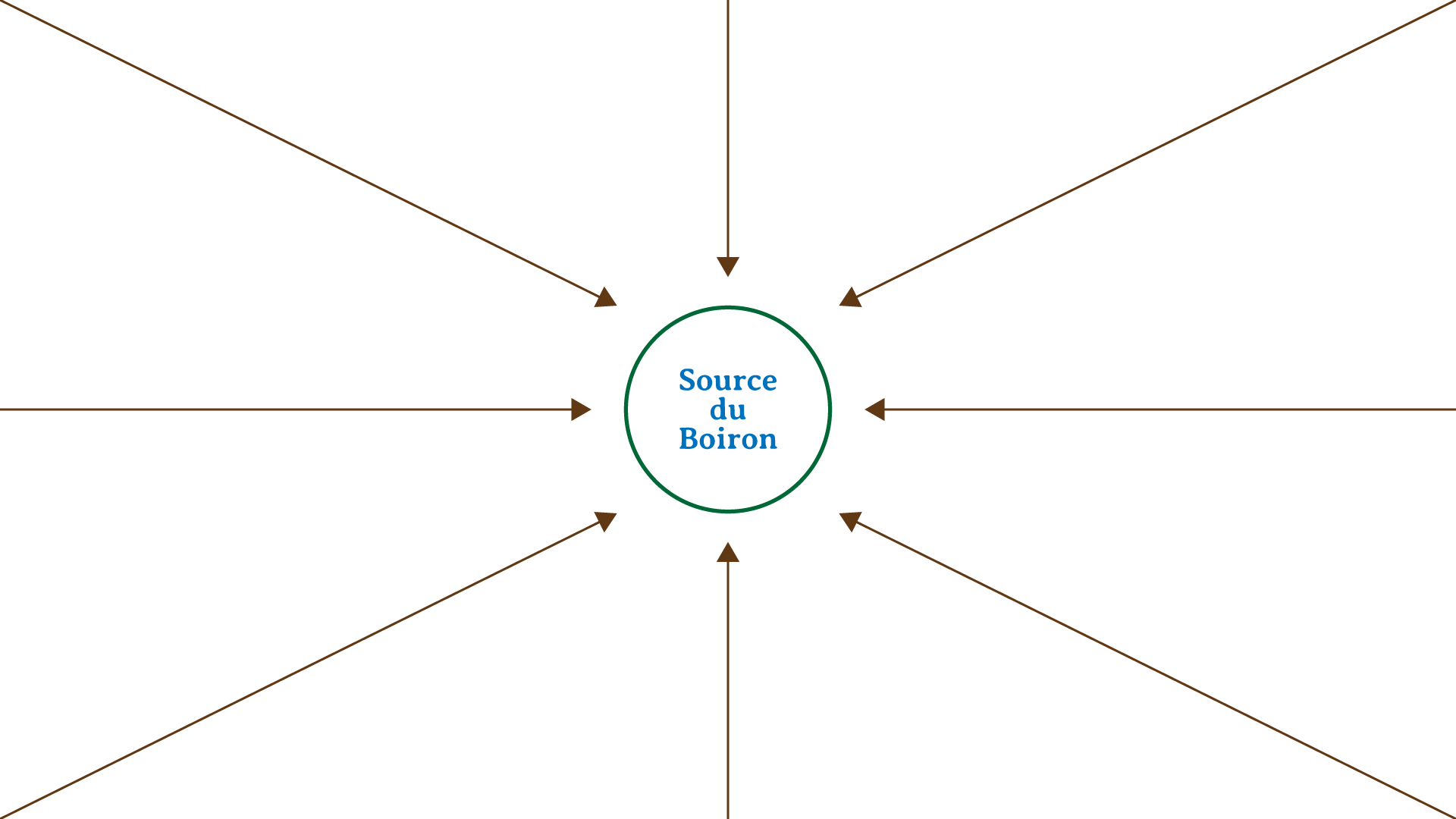
My protocol is to approach the source from multiple angles. In most cases, people access the source from one path. I wanted to see what the experience would be like if I approached it from other directions. In practice, this would be dangerous here because to climb down from the cliff I can injure myself. If I had the proper equipment maybe I could do it. This protocol can also be extended not to just the location, but from a creative standpoint. How many ways can I respresent/depict/create with the source? Is there a particular medium that is best suited to tell its story?

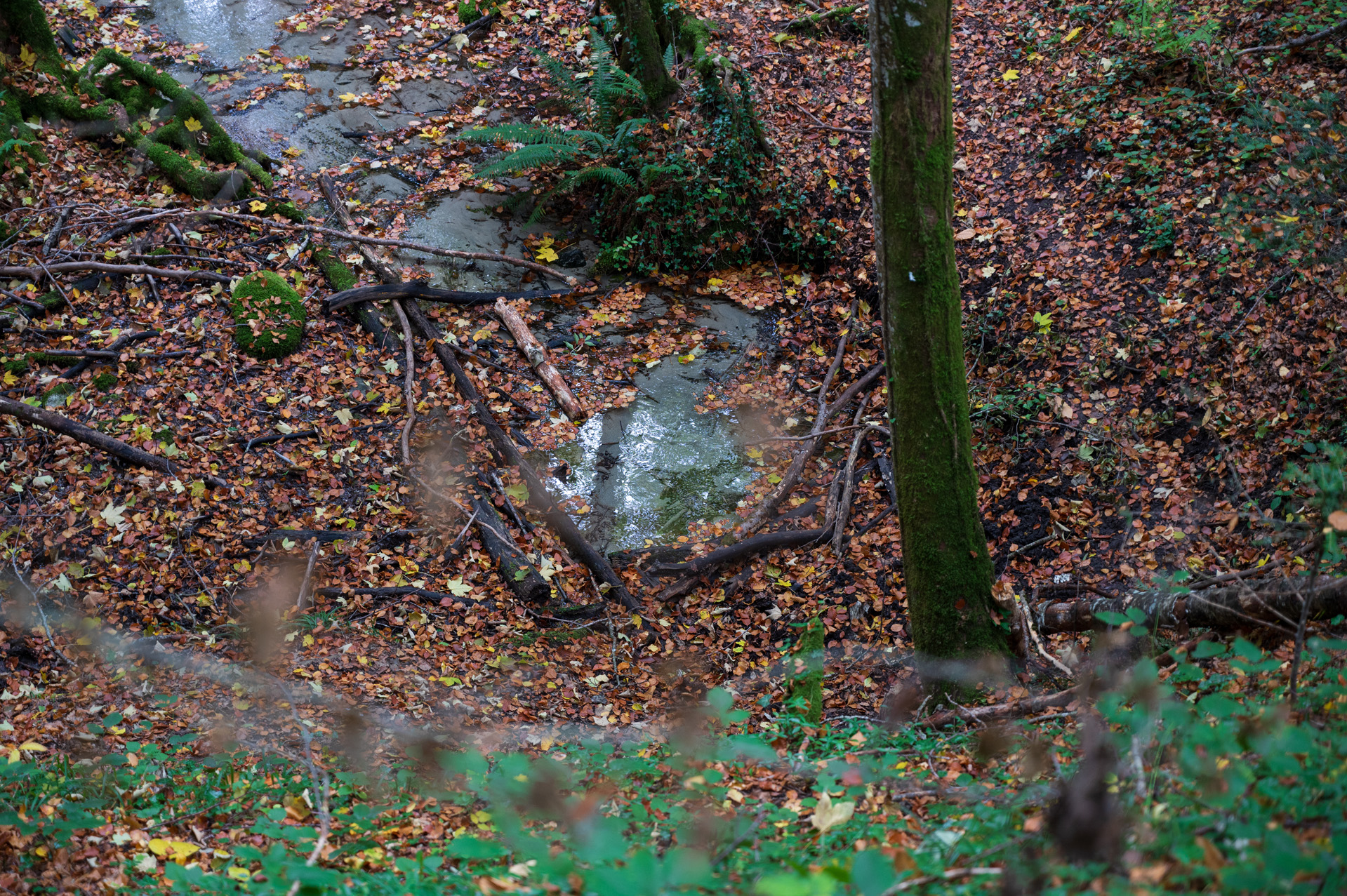
I did go up the cliff to get an overview of the source as my first POV. I initially went uphill too because I didn't want to disturb Benoît while he did his hydrophone recordings (which he shared with me if I wanted to use, so thank you!). I spent about 15-20 minutes up by the cliff. I don't know what I was looking for but maybe to see if I could find traces of water still somewhere. I started to get scared that I would get lost because it's a forest with no defined path. This was my intention for my protocol, to be dis-oriented but I also didn't have cell reception so I didn't want to get completely stranded.
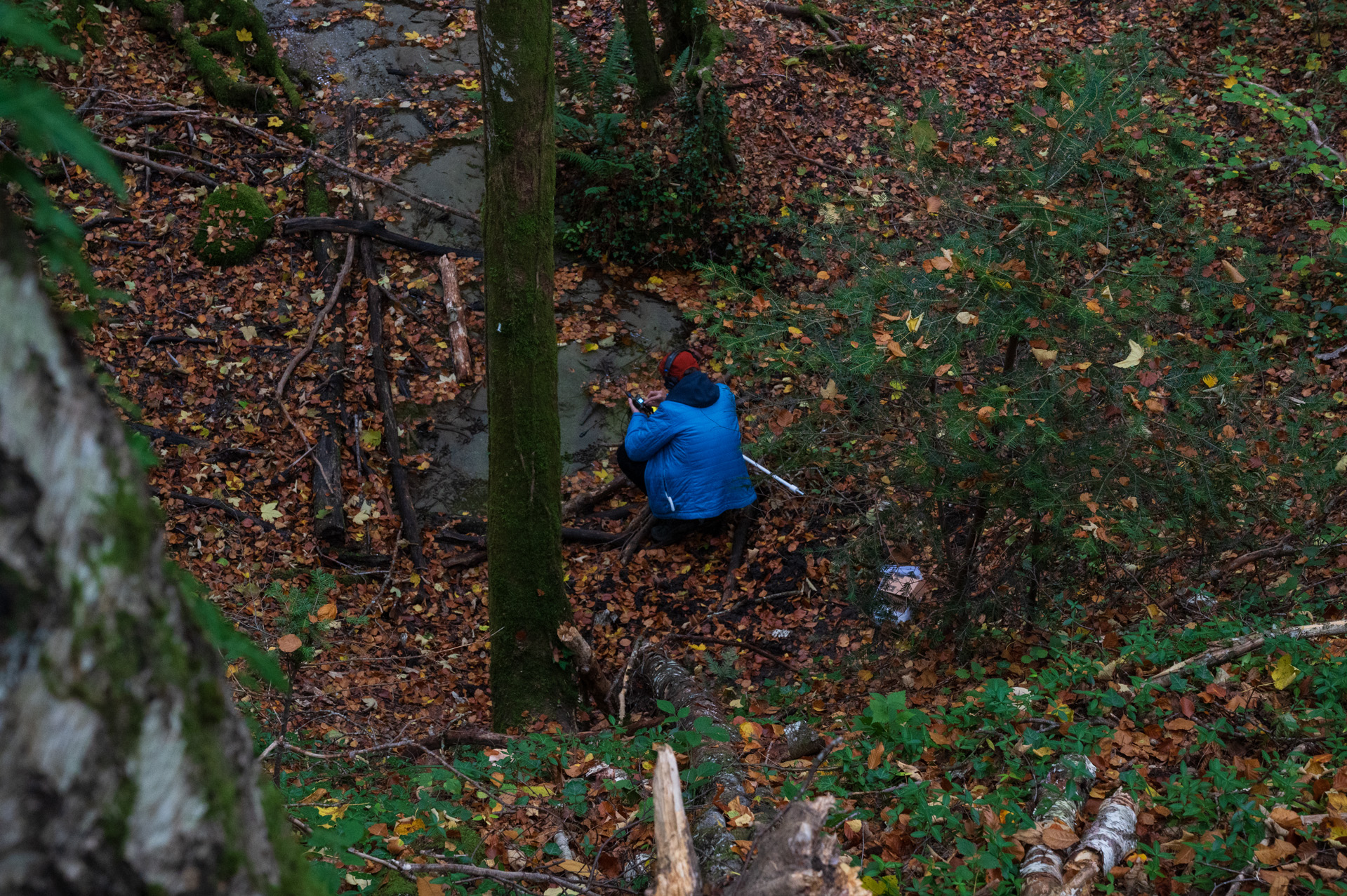
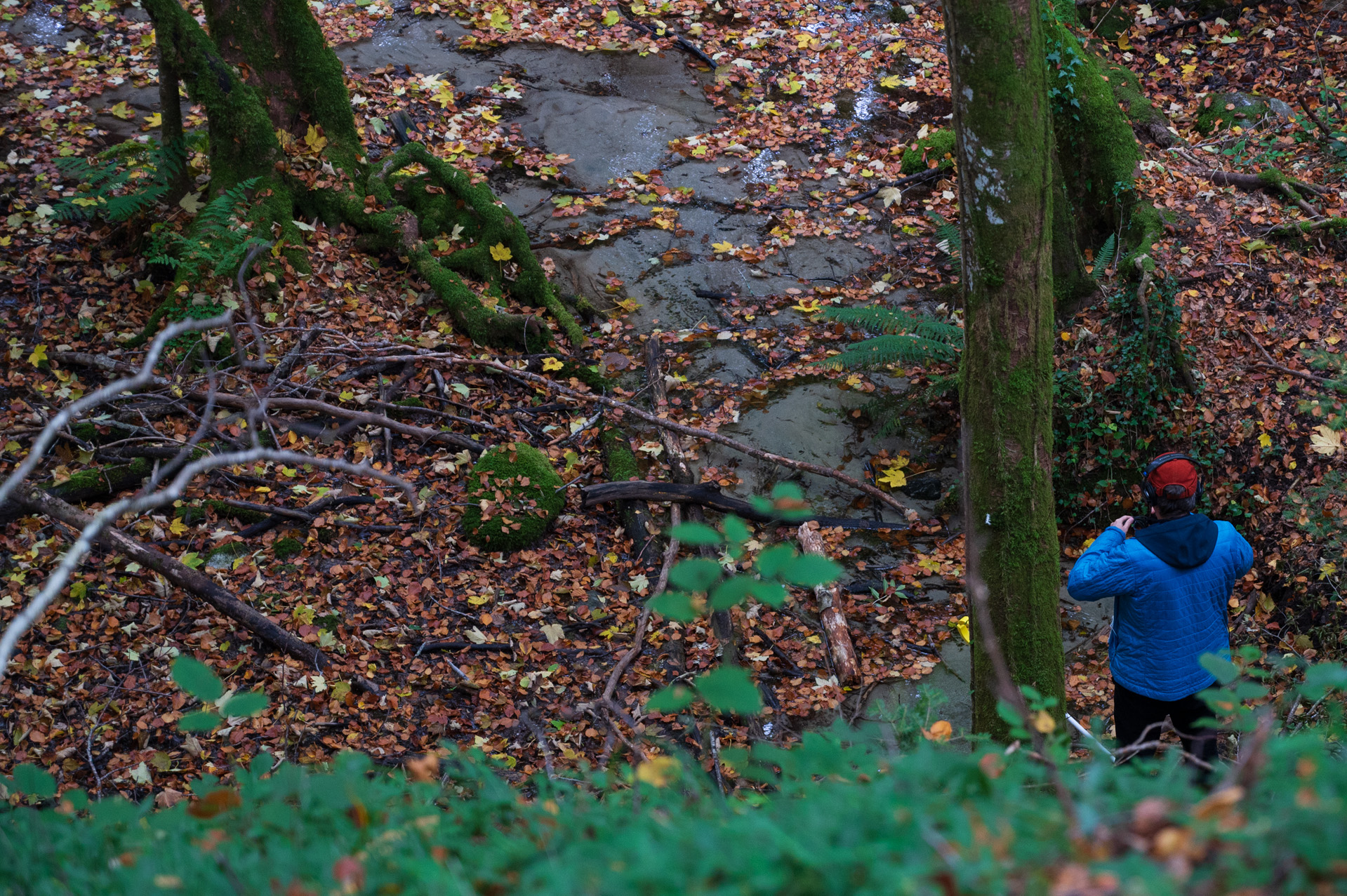
After wards I went back down and I wished that I had brought boots because it's muddy there and I also wanted to stand in the stream and approached it going upstream. Lastly, I didn't really do the protocol as planned since I was so drawn to the source.
Photogammetry
Before arriving at the location, I was thinking about my protocol and thought, what would be the technological equivalent? Photogammetry came to mind and I tried looking for free apps on Android. No free apps that I know of but I downloaded Polycam and on the trial verison. I would like to explore this technology further. It's pretty powerful that you can re-create an environment or object in 3D space with just your mobile device.
This also led me to think about digital twins and how scientists will re-create the environment as a way to study and test hypothesis. I wonder what would be the equivalent for design/art? What does it mean to have a digital twin of an environment?
Scan 1
Scan 2
Scan 3
Scan 4
Gaussian Splat Model
Then I tried uploading a series of images of the source to create a gaussian splat model. I was curious to see how Polycam would interpret the flow and movement of the source.
Photographic Study of Boiron's Movement
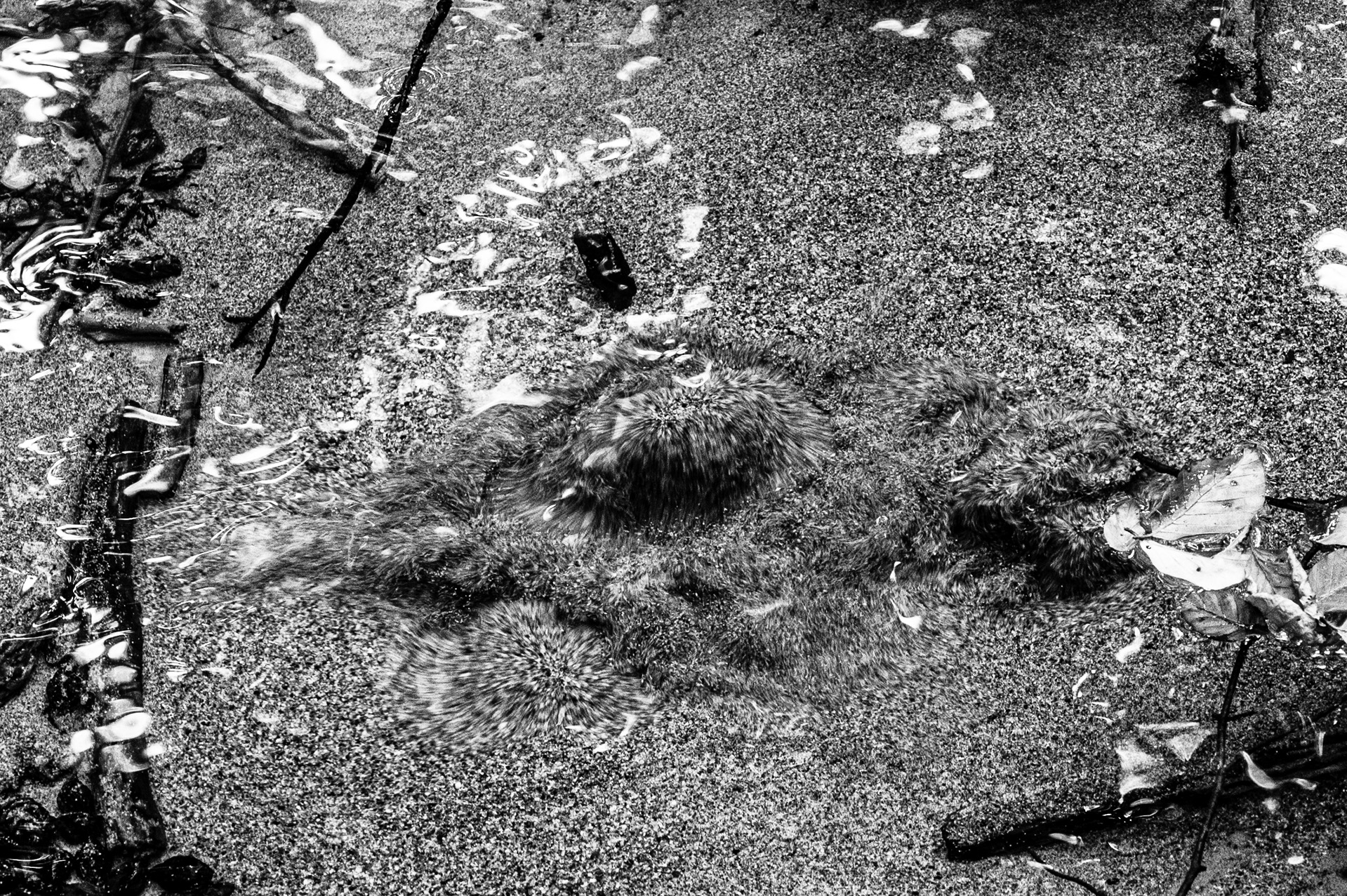
This reminds me of Muybridge and capturing the locomotion of a horse. The choice of B&W in his study was because of technological limitations since colour film wasn't invented for another 50 years after his study.
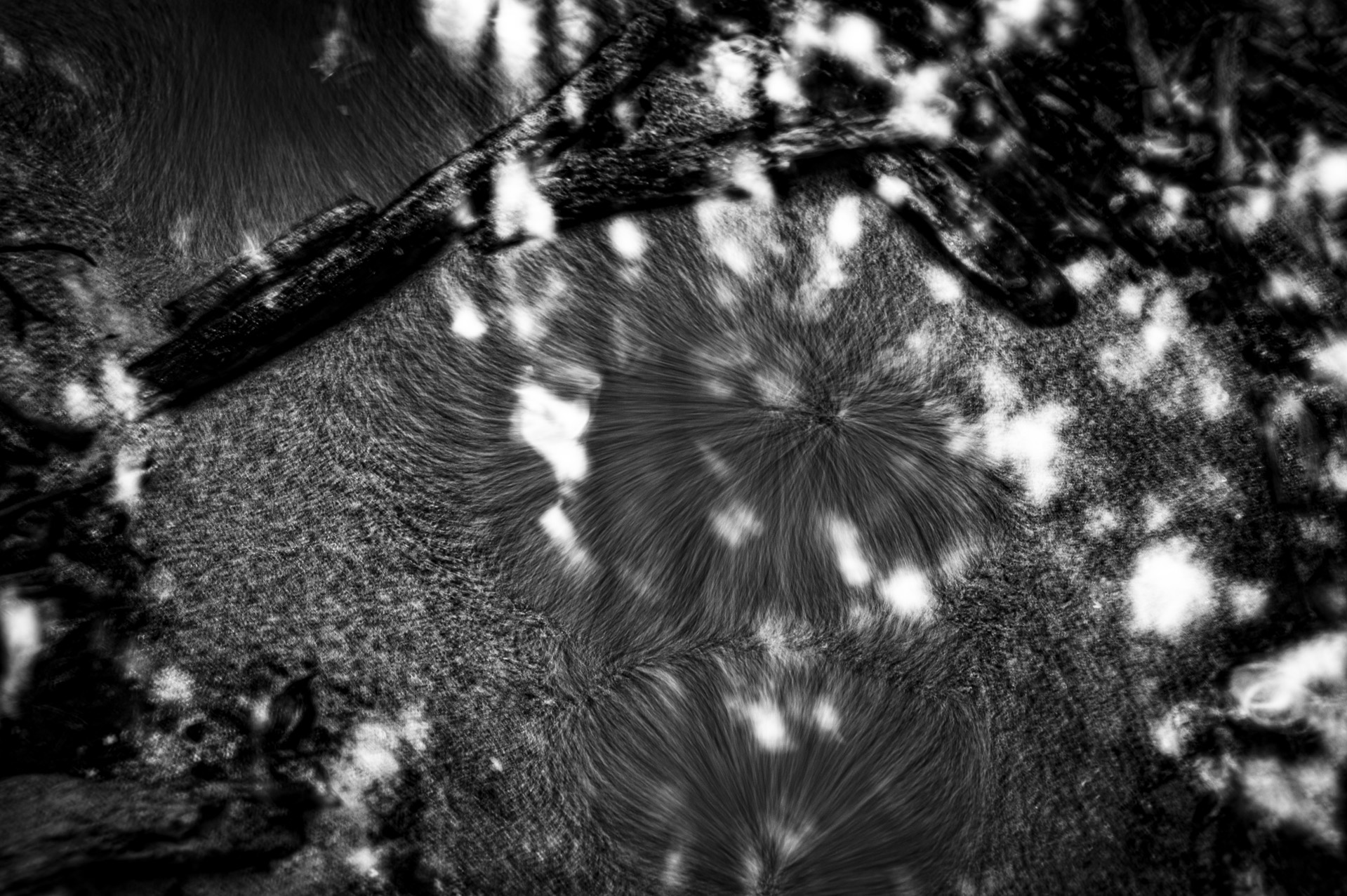
But the lack of colour meant that we could focus on movement and form. This is the benefit of black and white imagery and perhaps a good choice to present the Boiron's form since it's colour isn't that all interesting, where in contrast to the Rhône and the confluence with the Arve, the colours is what highlight's the rivers' beauty.
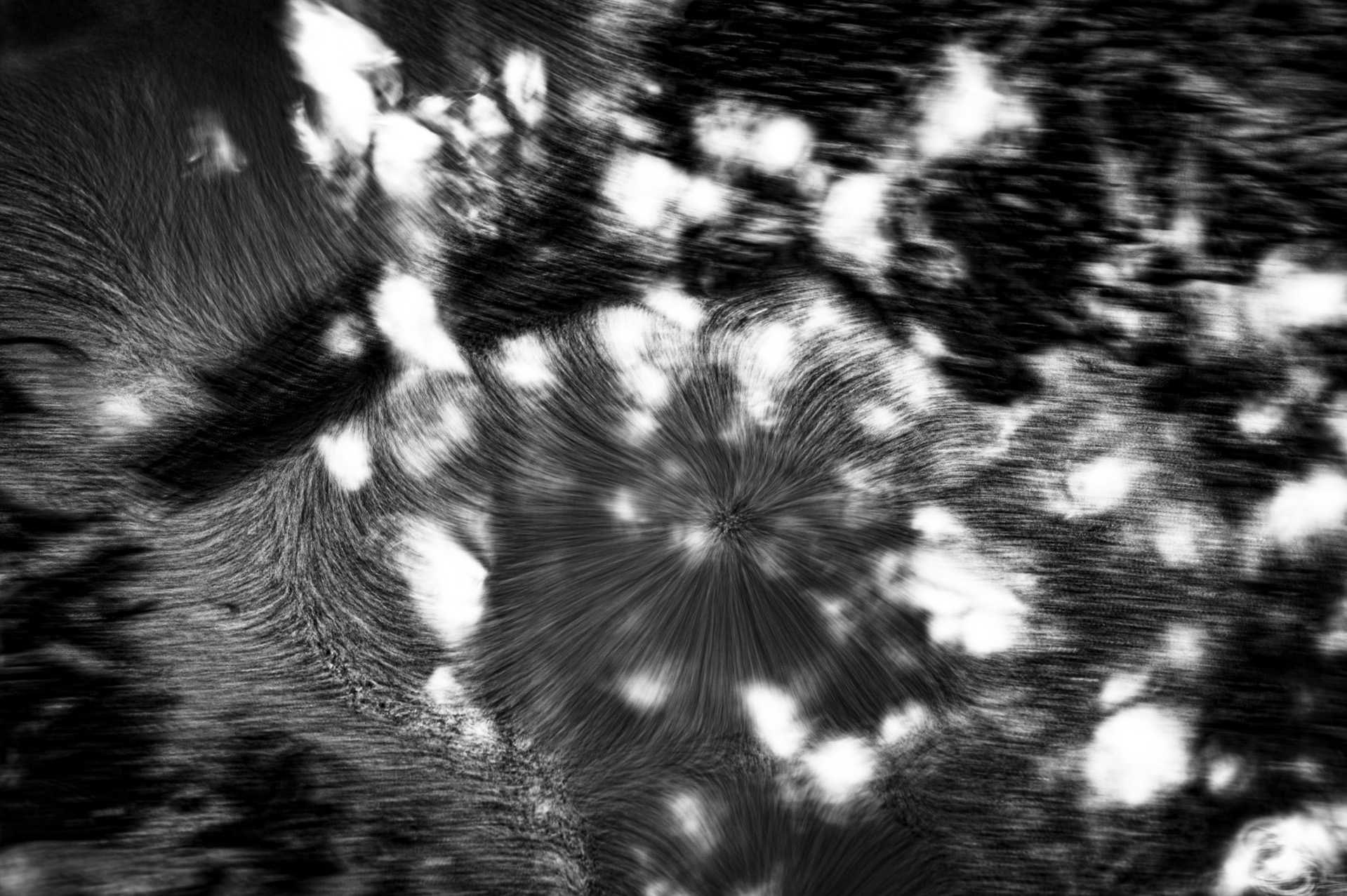
Another thing to note, the Boiron's visual beauty is to be appreciated upclose where the la confluence is afar. Two different scales and relationships. What I've learned from the observations is that you really need to be with the environment to find all the different angles and perspectives. Similar to how we say we have a good side (good angle for taking a photo), what is the good side of nature? What is the angle to present nature?

Anyway, this photographic study was to yes capture an aspect that's hard to perceive with just our eyes, but to inform what Boiron's form could be. If environmental aesthetics is about appreciating nature as nature, then to think of it's imaginary fictional form should also be from the same point of view.
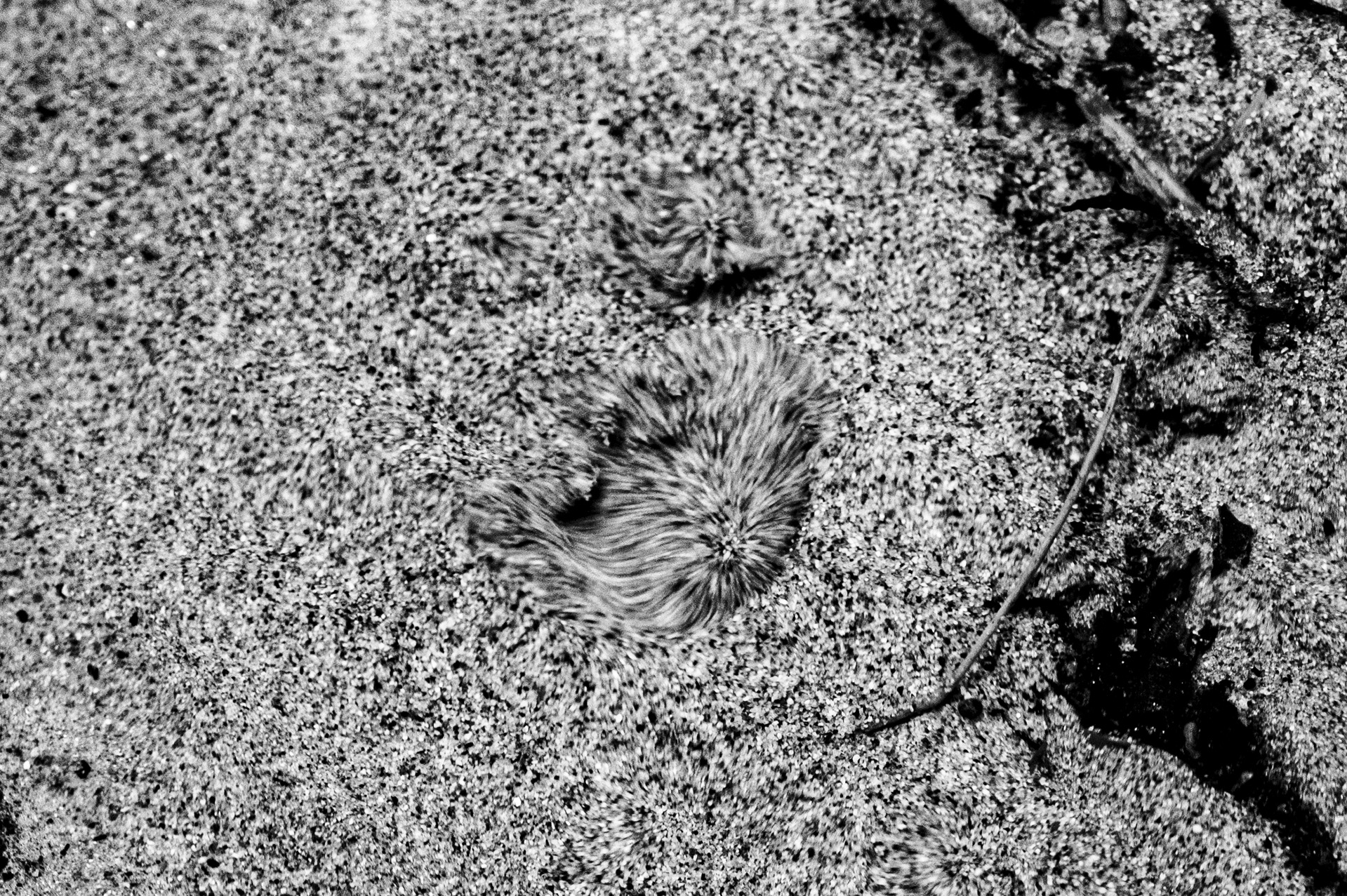
I have a lot of these photos. I would like to maybe create a print catalog and present them like a scientific observation of this "living creature".
Transcript
Mostly about what people's protocols are since this was discussed in the morning before we did our own thing.
Read Day 3 Transcript
Day 4
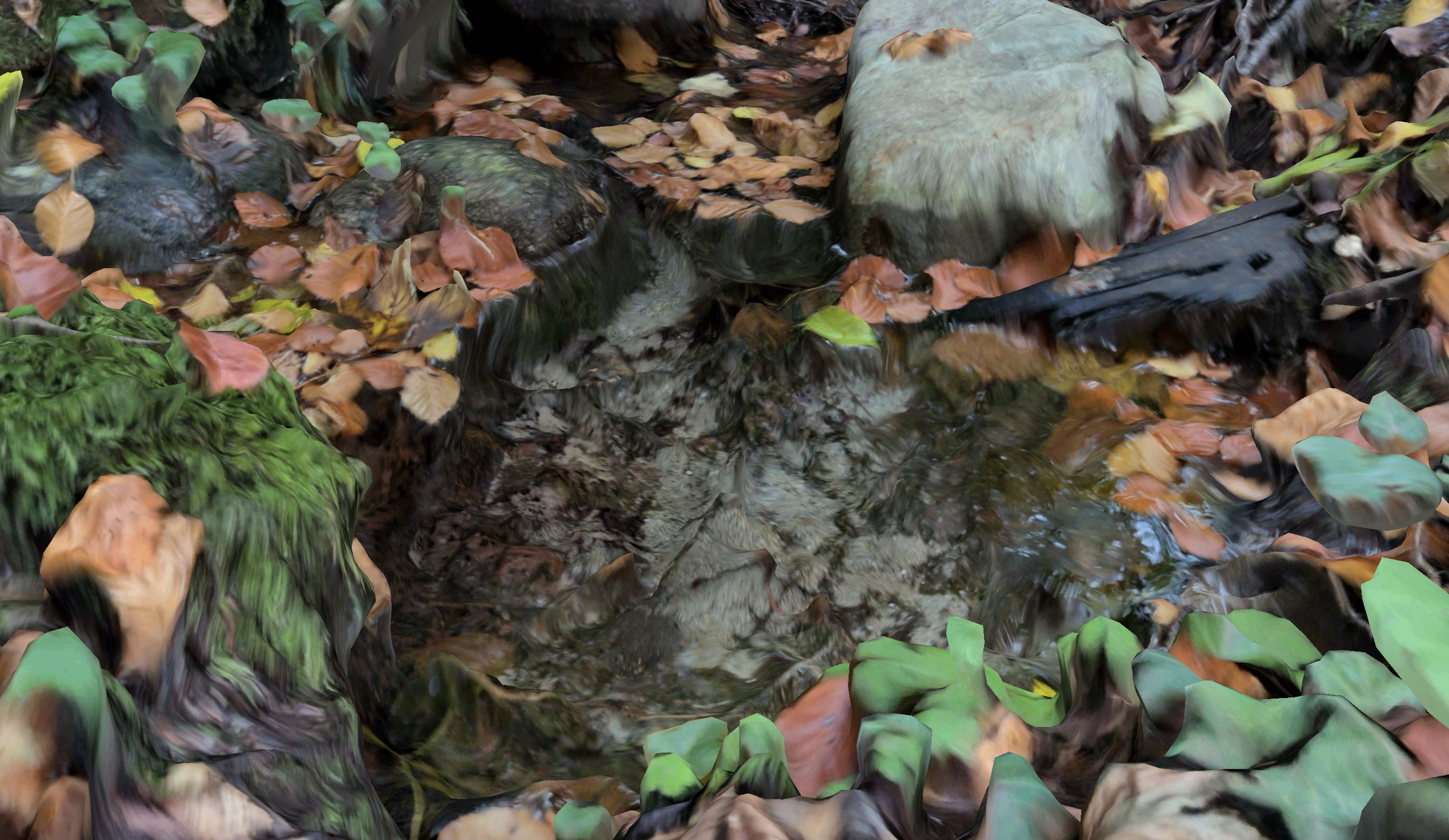
We shared and presented what we did the previous day. The purpose was to showcase our protocol and use our observation to create a piece of work out of it. I knew I wanted to do something about the source since Day 1 after seeing it. And since I still have a chapter to write in my thesis about personhood/voice/representing river I thought this could also be a good opportunity to explore this through a practical sense.
I was inspired by Jean-François Ruben quote, "C'est un endroit magique." and how he views the forest and river as a magical place. Which also what drove him to create a tale about a fairy named Gouttelette. I wanted to tap into this world and expand on it through the lens of personifying a river. In "Personifications of Rivers as an Element of Roman Political Propaganda" by Janusz A. Ostrowski, he sees the human form of rivers in two categories: mythological-decorative and realistist-propaganda. This is from the Roman perspective which is also informed by Ancient Greece.
The short story (and maybe more like a description) I've written is part myth because I wanted the Boiron to be this fantastical being yet use the story as propaganda to communicate the mistreatment and abuse of the river. Maybe propaganda isn't the right word, but essentially the story is used to share the problematics. The river's source comes from underground and it meanders for a bit before we've forced it back underground through a pipe. In addition, because of agriculture and wine production, the pesticide chemicals infilitrate the river. There are other problems too such as the built environment altering the landscape of rivers but I haven't taken this into consideration when writing my very short story.
The Search for Boiron's Form
Photogammetry Aerial View
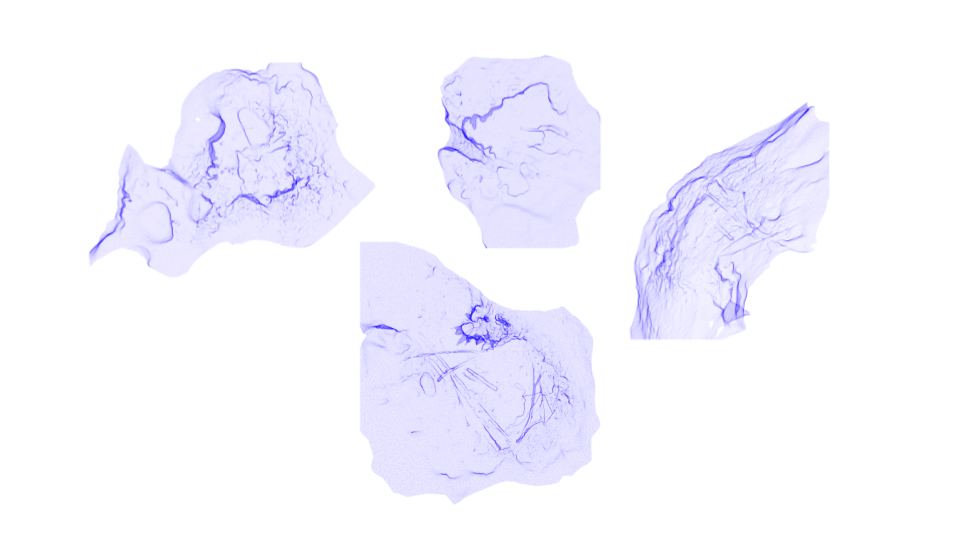 These are exports from the aerial plan of the photogammetry models. The shape and colour is determined by Polycam. What I find interesting is that I don't see these are geographic plans, but instead illustrations. For example, these look like fish, a head with a face, intestine or bacteria. Of course, these aren't 100% accurate because this is taken from a series of photos on my phone and then converted to 3D models. But what I'm looking for here is a process of creating a form of the Boiron based on it's location, based on what is unique to it.
These are exports from the aerial plan of the photogammetry models. The shape and colour is determined by Polycam. What I find interesting is that I don't see these are geographic plans, but instead illustrations. For example, these look like fish, a head with a face, intestine or bacteria. Of course, these aren't 100% accurate because this is taken from a series of photos on my phone and then converted to 3D models. But what I'm looking for here is a process of creating a form of the Boiron based on it's location, based on what is unique to it.
Long Exposure Photos
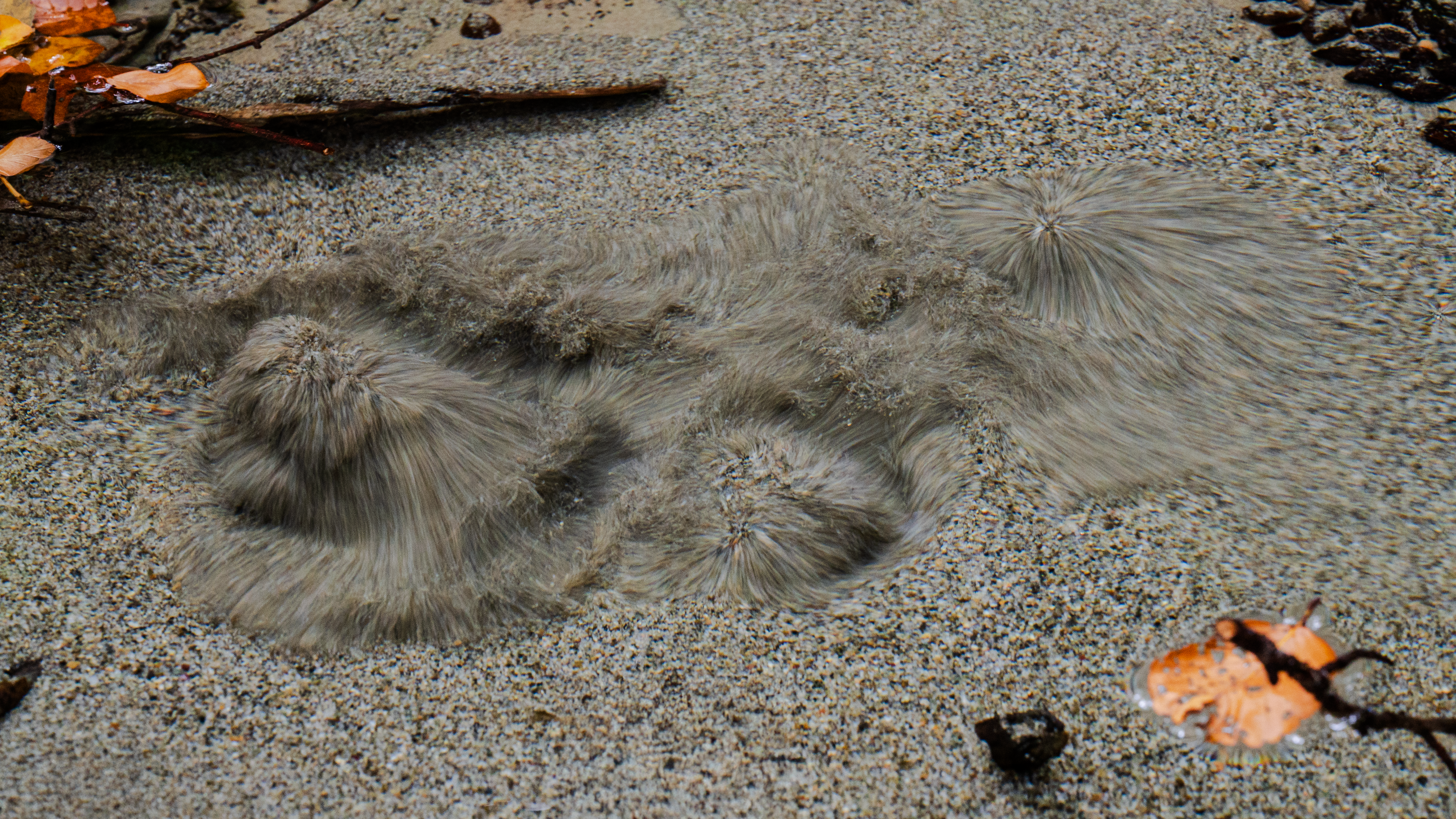
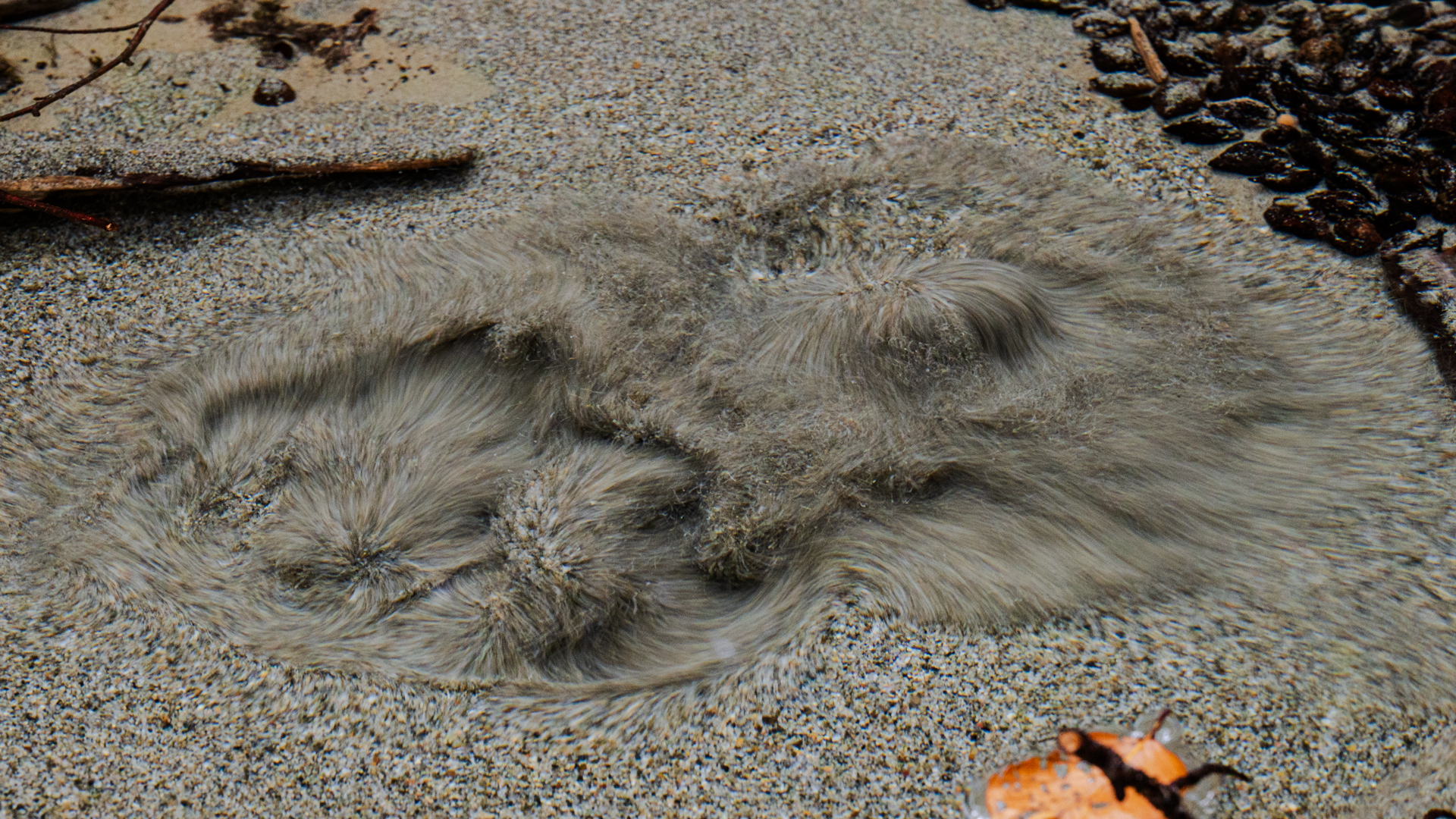 Treating them black and white to focus on their form but also this also feels like an image you might see in an old science textbook.
Treating them black and white to focus on their form but also this also feels like an image you might see in an old science textbook.
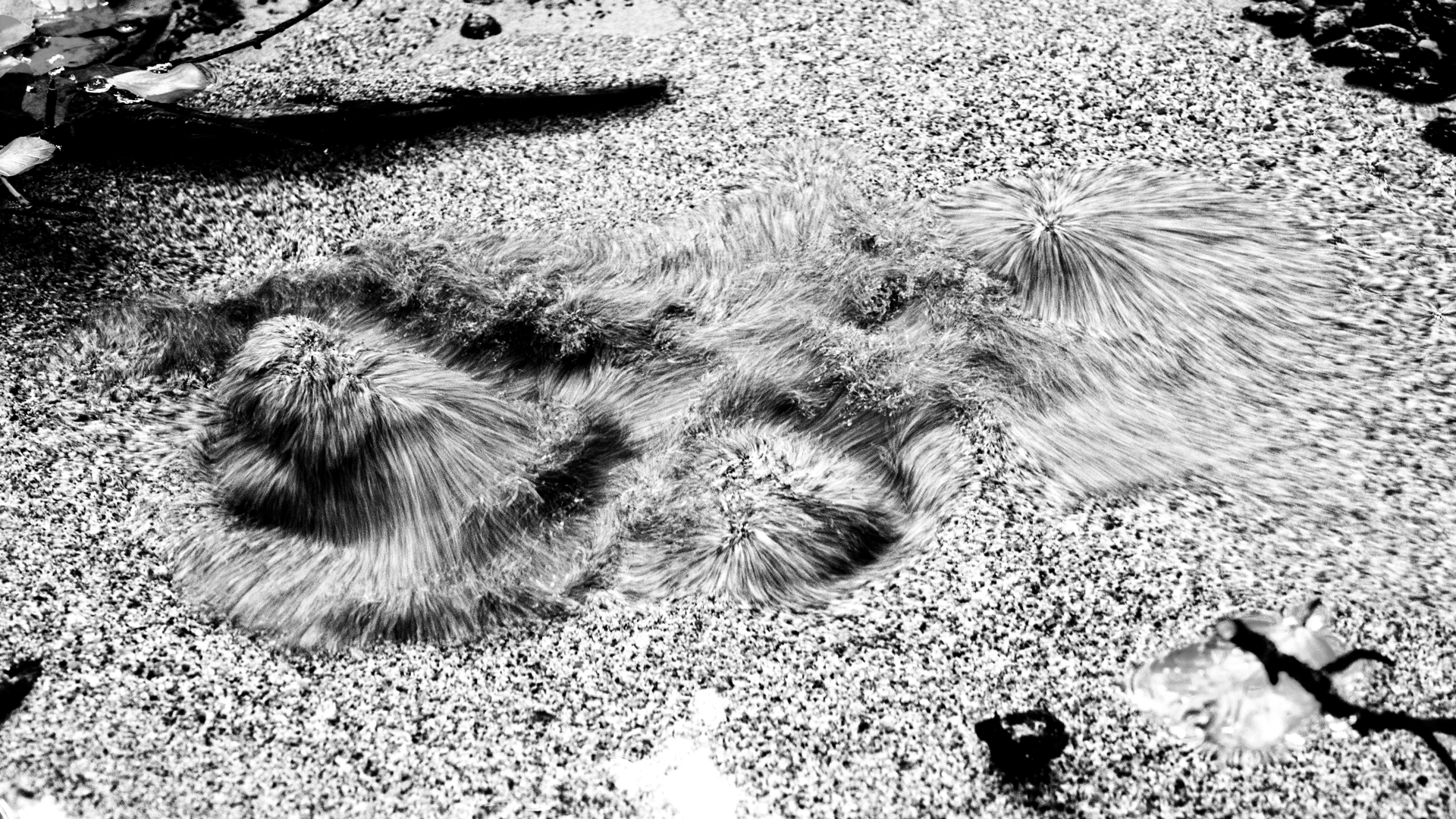
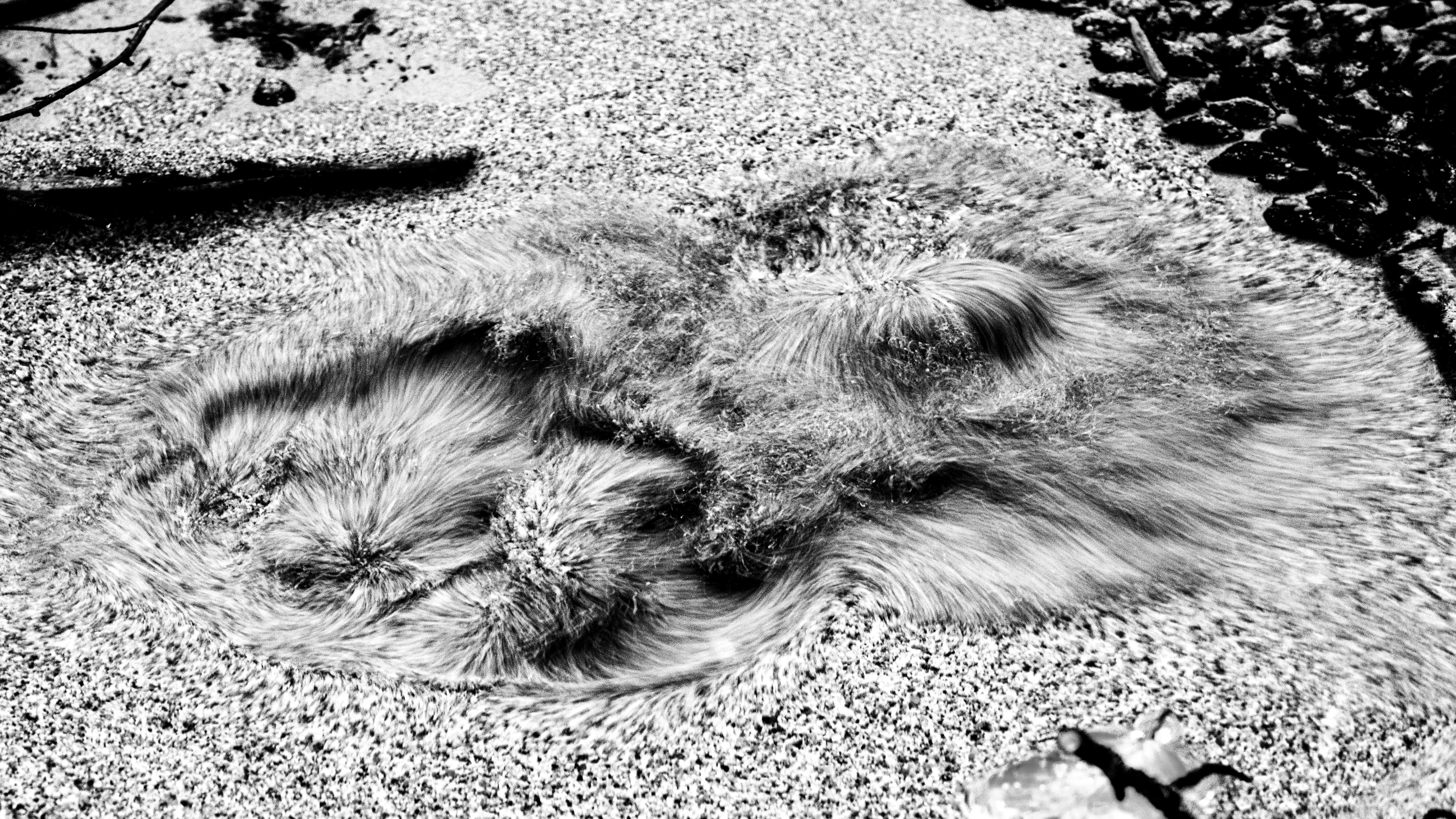
Captures the liveliness even if it's a still, while also giving some shape to what the starting form of Boiron could be.
The Language of Science
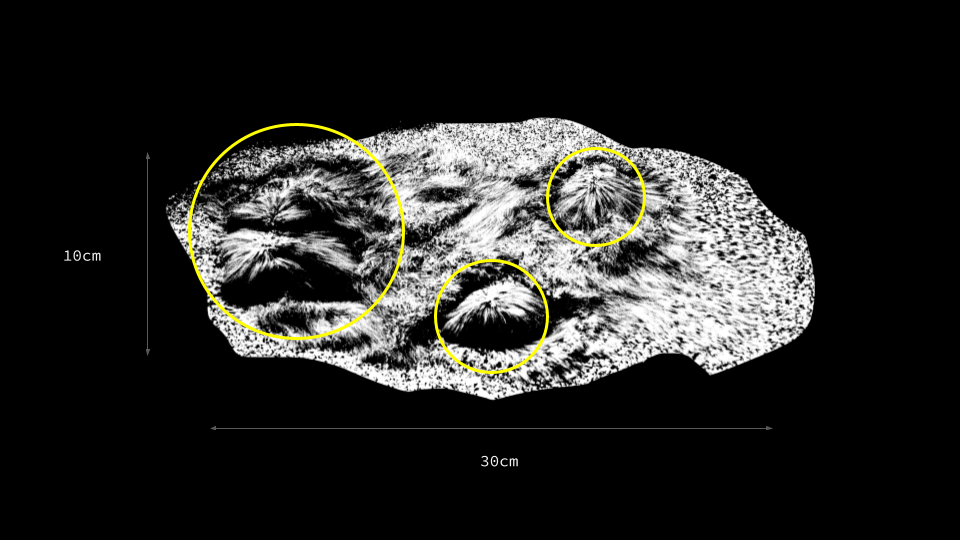 Using measurements and scientific diagram to give form to the Boiron. From Yuriko Saito, "Science can be regarded anthropocentric in a conceptual sense, too. Stan Godlovitch, for example, challenges Carlson’s view by holding that science still does not tell us nature’s story; rather, it tells our story." An interesting take. If everything that humans do, is it then considered anthropocentric because it will be from a human point of view? When we measure, this is for us to understand scale in relation to us. For nature, do they care about this metric?
Using measurements and scientific diagram to give form to the Boiron. From Yuriko Saito, "Science can be regarded anthropocentric in a conceptual sense, too. Stan Godlovitch, for example, challenges Carlson’s view by holding that science still does not tell us nature’s story; rather, it tells our story." An interesting take. If everything that humans do, is it then considered anthropocentric because it will be from a human point of view? When we measure, this is for us to understand scale in relation to us. For nature, do they care about this metric?
Movement





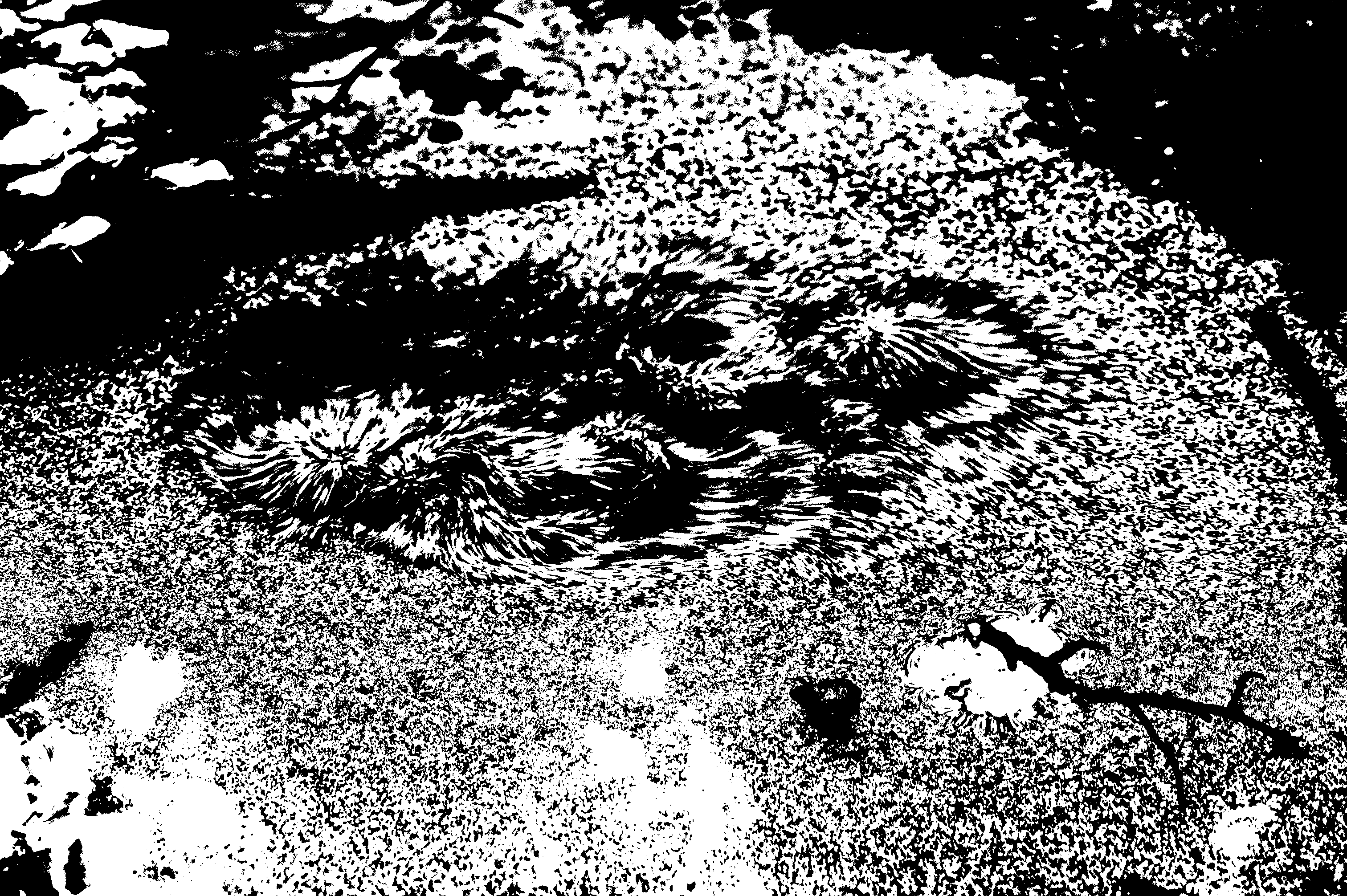 The movement has a lot of character. As one person noted from the workshop, she said that there's something dark about the Boiron. I replied, yes, it's not 100% positive and I think this is part of the Boiron's allure.
The movement has a lot of character. As one person noted from the workshop, she said that there's something dark about the Boiron. I replied, yes, it's not 100% positive and I think this is part of the Boiron's allure.
Image to 3D
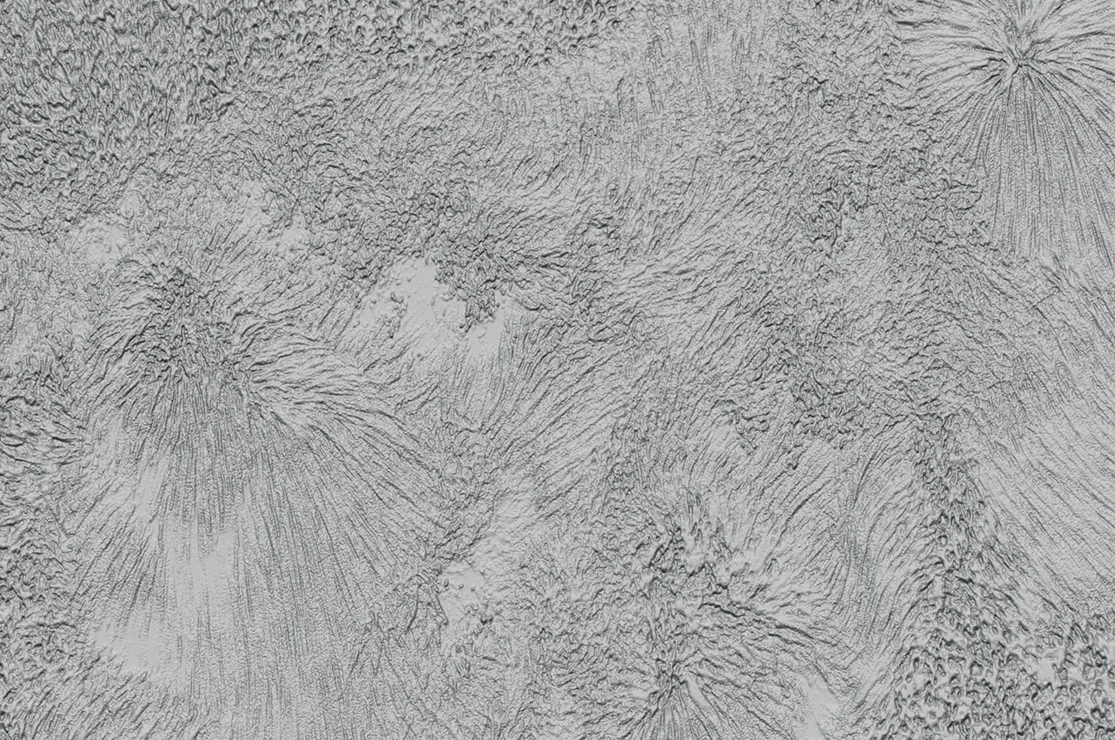 One of the first title of my thesis was "Fingerprints of Rivers" and it's something that I would like to explore still within the context of giving form to a river. This is done in Blender by using a black and white image as a heightmap. My question is, what makes each river unique and how can it be identified through a visual output?
One of the first title of my thesis was "Fingerprints of Rivers" and it's something that I would like to explore still within the context of giving form to a river. This is done in Blender by using a black and white image as a heightmap. My question is, what makes each river unique and how can it be identified through a visual output?
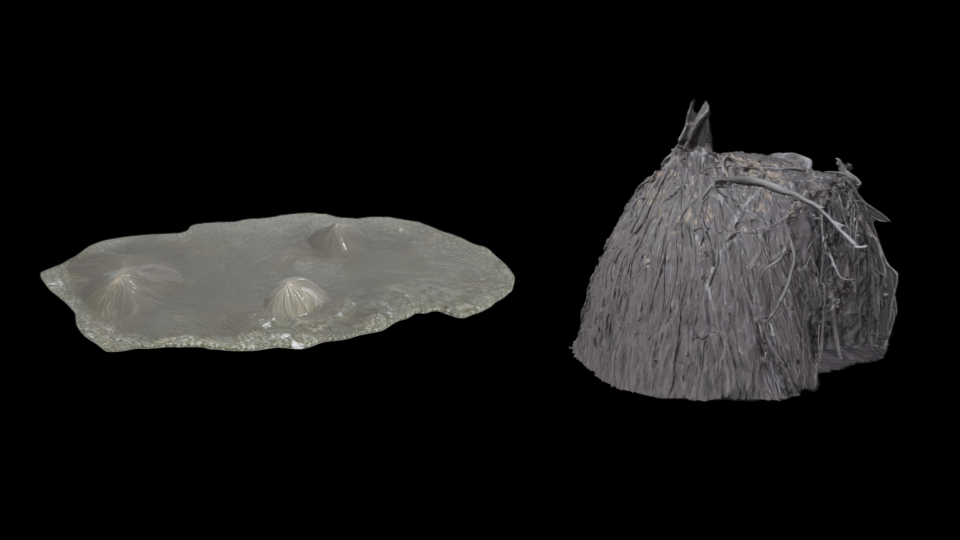 Using images to convert them to 3D models from Makerworld. These are very basic and would require texturing and editing the models to communicate what's captured through the previous photos.
Using images to convert them to 3D models from Makerworld. These are very basic and would require texturing and editing the models to communicate what's captured through the previous photos.
The Tale
Bébé Boiron emerges from the surface. He’s desperate to escape the underground world and frees himself through tiny portals to the above world. Born from a mysterious place, we didn’t know what to make of him. So, we locked him up in a cage and forced him back to the subterranean world. We used and poisoned him. When he resurfaced, he was no longer his bubbly self. He became Boiron the Beast.
Reflection
I am thankful to Benoît and Marion for organizing this 4-day research workshop and for inviting me to participate. Even though 95% of the time was in French and I was a bit lost, I am proud of myself for being in a situation that I would have in the past found incredibly uncomfortable.
The day after, I was feeling exhausted which is a contradiction to what nature is supposed to do for us. It should have restorative powers for us but when it's in a work context, it can be tiring. To work with the land, to be with the land, to take time to understand it and to try to connect to it, it takes effort.
After my presentation, Jean-François asked if he can have the black and white image. This made me very happy because part of my practice, especially with nature, is to leave the place better than you found it. Think this comes from me camping in Canada and people saying it. I don't think it just has to be with the environmental aspect, but it can also be contributing to knowledge or spirtituality which in this case, I think I've done with capturing the Source du Boiron's Beauty. I saw a smile on Jean-Francois face when I was presenting, so that's a win in my book.
There's a lot of things that I want to try now with the Rhône and Arve. I will try to recreate the junction using photogammetry. This location is a lot larger so it will be interesting how far I can push the technology with just my phone. The B&W treatment to photos and locomotive studies can also be applied to the movement of the confluence. I'm now visualizing it and I can see it being this elongated, serpent, smoke like entity.
There will be a follow up to this since the organizers are thinking of creating a publication as an archive of the work we've done. I also would like to incorporate Benoît's sound recordings of the source. Maybe with the Gaussian Splat model as an audio-reactive piece. Not sure yet.
Bibliography
HEYD, T., 2001. Aesthetic Appreciation And The Many Stories About Nature. The British Journal of Aesthetics. Vol. 41, no. 2, pp. 125–137. DOI 10.1093/bjaesthetics/41.2.125.
OSTROWSKI, Janusz A, 1990. Personifications of rivers as an element of Roman political propaganda. Étude et Travaux. Vol. 15, pp. 309–316.
SAITO, Yuriko, 2004. Appreciating Nature on Its Own Terms. In: CARLSON, Allen and BERLEANT, Arnold, eds. The aesthetics of natural environments. Peterborough, Ont.; Orchard Park, NY: Broadview Press, pp. 141–155. ISBN 978-1-55111-470-5.
← Back to garden